Chiang Mai. It’s like a “low-key student” of Thailand who scores well in every exam but not many people in the school know about him. Because he’s a non-glamorous student (unlike Bangkok, Phuket and Koh Samui) who doesn’t indulge in extra curricular activities (marketing). In this post I’ll primarily discuss what to do in Chiang Mai in 3 days besides other basic things you need to know about this wonderful city.
WHY VISIT CHIANG MAI?
I chose to visit Chiang Mai with my family for three reasons –
- It’s rich cultural heritage and historical background owing to the fact that it was the capital of the various ancient kingdom of Thailand for almost 700 years.
- A lesser crowd and far more natural beauty as compared to the other cities in Thailand.
- The sheer variety of things to do in Chiang Mai.
- Because it’s just the “travelling” you want to do before exploring the gorgeous islands of Thailand like Krabi and Koh Lipe.
My trip to Thailand would have been incomplete if I hadn’t spent 3 days in Chiang Mai, the most significant cultural hub in northern Thailand.
Now your question would be – Are 3 days in Chiang Mai enough? How many days in Chiang Mai would be appropriate so that we can explore the best of Chiang Mai?
To that, I’d like to answer by saying – Yes, you can explore the best of what Chiang Mai has to offer in 3 days!
WHERE IS CHIANG MAI?
Chiang Mai is the largest city in northern Thailand. It’s the capital of Chiang Mai Province and situated about 700 km to the north of Bangkok. It sits in the beautiful Thai countryside along the banks of Ping river surrounded by the highest mountain ranges in Thailand.
Interestingly the highest mountain peak of Thailand ie. Doi Inthanon ( 2,565 m) is situated in the Chiang Mai province. Chiang Mai (meaning “new city”) was founded in 1296 as the capital of the ancient Lanna kingdom. It’s situated at an elevation of 310 m above sea level and it’s current metropolitan area has a population of about 1 million.
CHIANG MAI WEATHER – WHEN IS THE BEST TIME TO VISIT CHIANG MAI?
The best time to visit Chiang Mai is when the weather is cool & dry ie. November-February. The weather is at it’s best during this period with a pleasant breeze cooling things across the territory. There’s also a couple of Thai festivals you can catch like the Loy Krathong in November and the Flower Festival in February.
The cheapest time to visit Chiang Mai is late April-October which is the monsoon season in Chiang Mai. Very few tourists come to Chiang Mai during this period, therefore the hotel and flight rates drop considerably.
March-April period is pretty hot with sporadic rains. Since April is the time of the Thai new year, the hotel and flight rates shoot up.
HOW TO GET TO CHIANG MAI?
You can easily get to Chiang Mai as there are multiple options that suit every person’s budget & time. You can travel to Chiang Mai via flights, trains, buses or by taxi.
1) Bangkok is the main point of contact so the most convenient way is to first reach Bangkok from your country and then book your journey from Bangkok to Chiang Mai.
- Flights from Bangkok to Chiang Mai – Duration: 1 hour 15 minutes. Book your flight tickets by clicking here. You can also book your flights on Skyscanner as they have some great deals and offers.
- Buses from Bangkok to Chiang Mai – Duration: overnight bus – 9 hours, Day bus – 12 hours (due to traffic). Book your bus tickets by clicking here.
- Trains from Bangkok to Chiang Mai – Duration: 11-14.5 hours. Book your train tickets by clicking here.
- Taxis from Bangkok to Chiang Mai – Duration: Around 8 hours. Book your taxi by clicking here.
2) To travel from Krabi to Chiang Mai, click here
3) To travel from Ao Nang to Chiang Mai, click here
4) To travel from Koh Phi Phi to Chiang Mai, click here
5) To travel from Koh Lanta to Chiang Mai, click here
6) To travel from Phuket to Chiang Mai, click here
7) To travel from Koh Samui to Chiang Mai, click here
WHAT TO DO IN CHIANG MAI IN 3 DAYS
DAY 1 :
Here’s a list of the things to do in Chiang Mai on the 1st day :
- Explore Wat Phra That Doi Suthep
- Visit the Bai Orchid and Butterfly Farm
- Meet the various tribes at the Long Neck Village
- Spend time at the Elephant POOPOOPAPER Park
- Explore the Bo Sang Umbrella Village
- Shop at the Night Bazaar
1) EXPLORE WAT PHRA THAT DOI SUTHEP
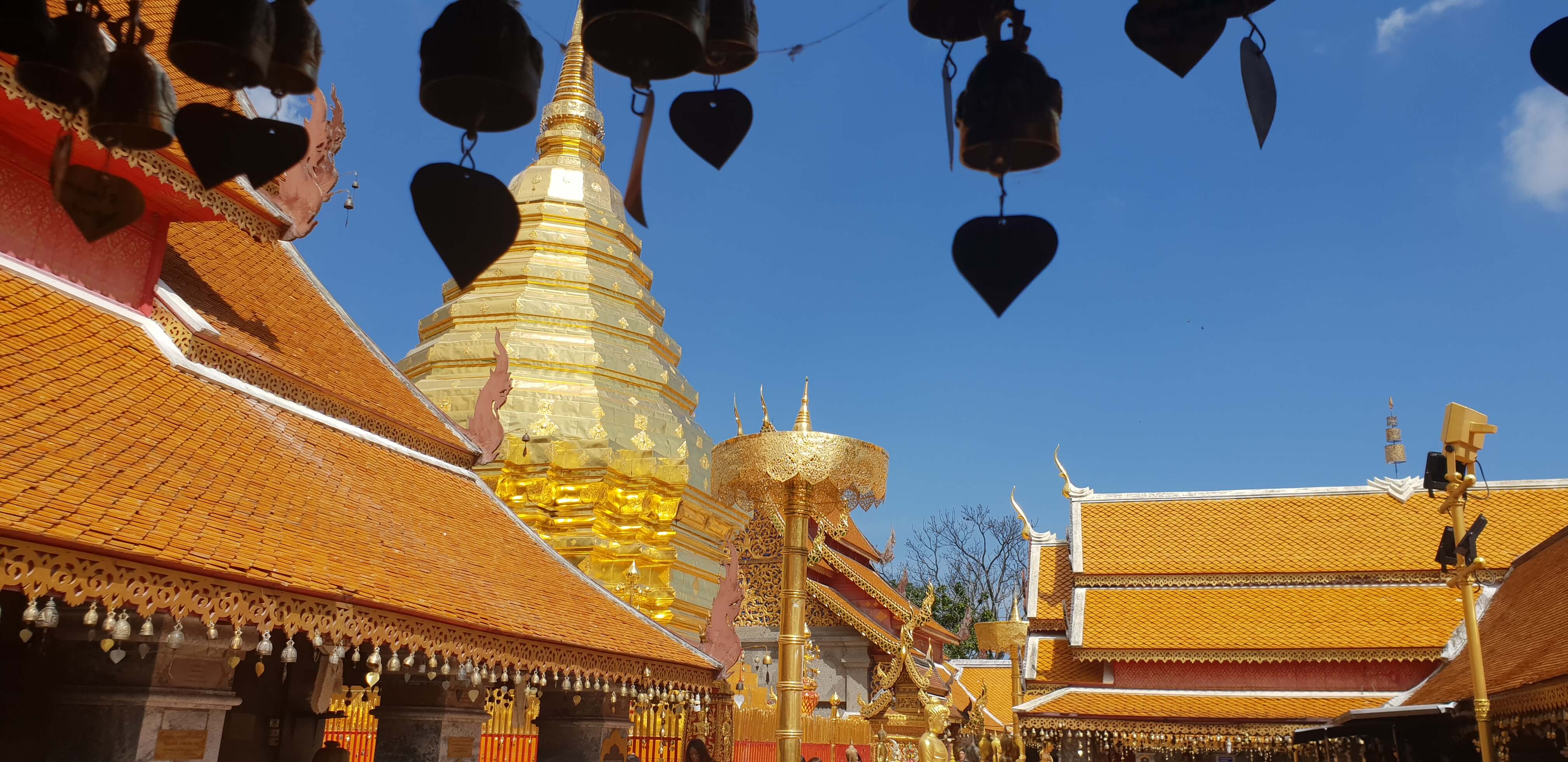
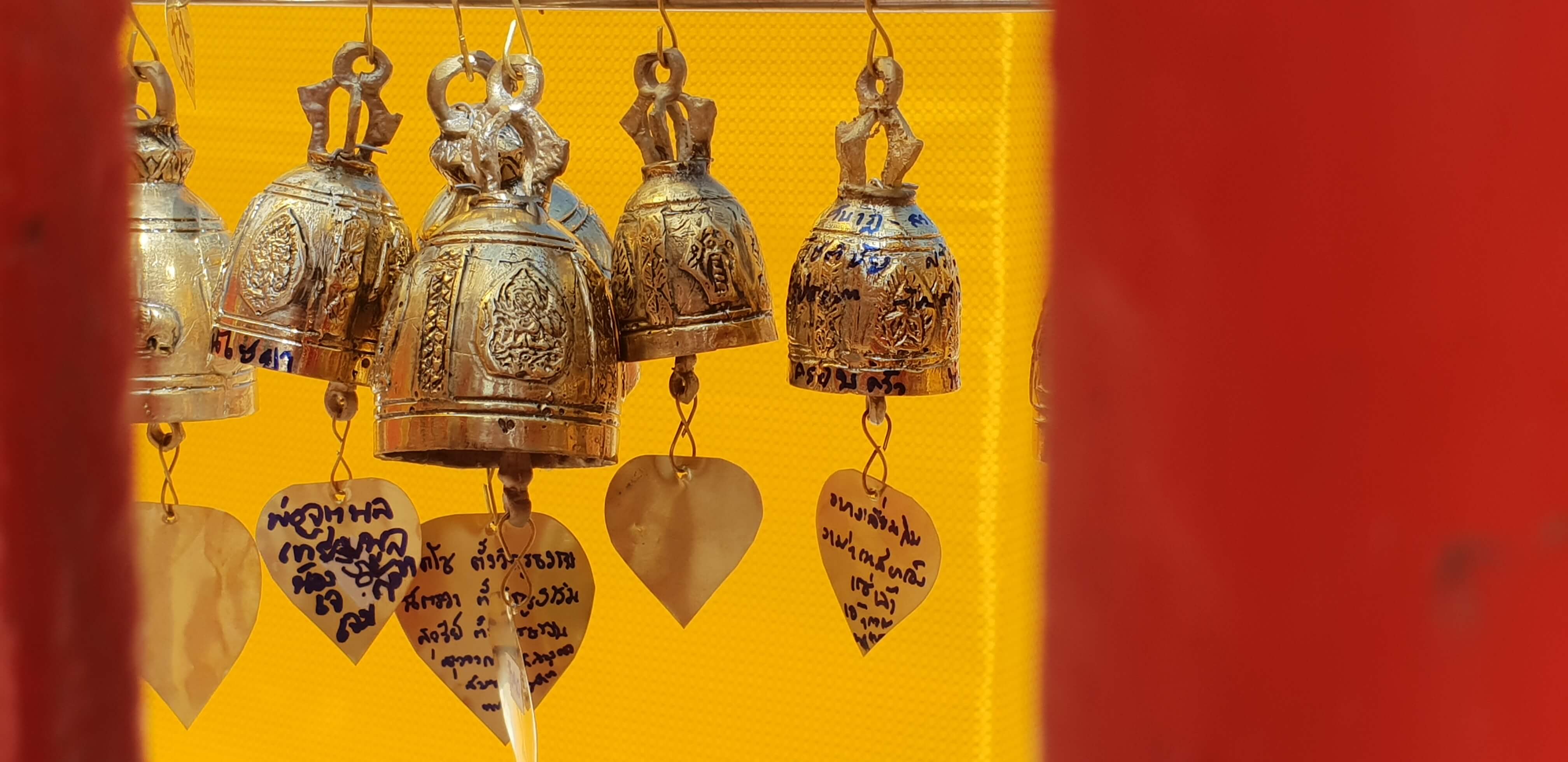
- The temple is 15 km away from Chiang Mai city and can be reached by road. In fact, you’ll enjoy the journey to the temple as the route’s scenic and there’s lots of greenery to be seen.
- You can reach the pagodas either by climbing 309 steps or by taking a tram. The admission fee to the temple is 30 Baht and the Elevator (tram) fee is 20 Baht per person.
- If you choose a tram, then climbing the stairs on your way to the tram you’ll see – a series of ATM’s lined up outside the ticket counter and women selling bells (thought to bring good luck) and lottery tickets to the visitors. Heck, if you’re lucky like me, then you might even get to see a dog with painted eyebrows.
- There are no views along the tram journey as such and you’re dropped at the terrace area of the temple. Here you’ll see a pagoda, a meditation room and a spellbinding panoramic view of the city of Chiang Mai.
- Walking further you’ll see a gallery of big bells, Buddha statues and a monk ordination chapel called “Ubosot”. The temple complex comprises pavilions, pagodas, statues & viharns.
- The pavilions contain statues, living quarters of monks, a souvenir store and a small cafe. There’s a museum constructed inside the temple premise where you can find ancient relics and photographs relating to the temple’s history.
- The sight of the sun rays falling on the main Pagoda embellished in gold is a feast for the eyes. It’s bordered by a railing to which several bells are tied as “wishes” by devotees. There’s an air of tranquility It’s believed that if you make a wish while walking around the pagoda 3 times, then your wish comes true.
- On your way down the stairs, you’ll see kids from the Hmong tribe pestering you to click photos with them. Remember if you get clicked with these little adorable cutiepies, then you’ll have to pay them in cash or kind (read: food).
- Don’t forget to sip some fresh coconut water or have a bite of the delicious strawberries in the small food stalls that are present at the base of the temple complex.
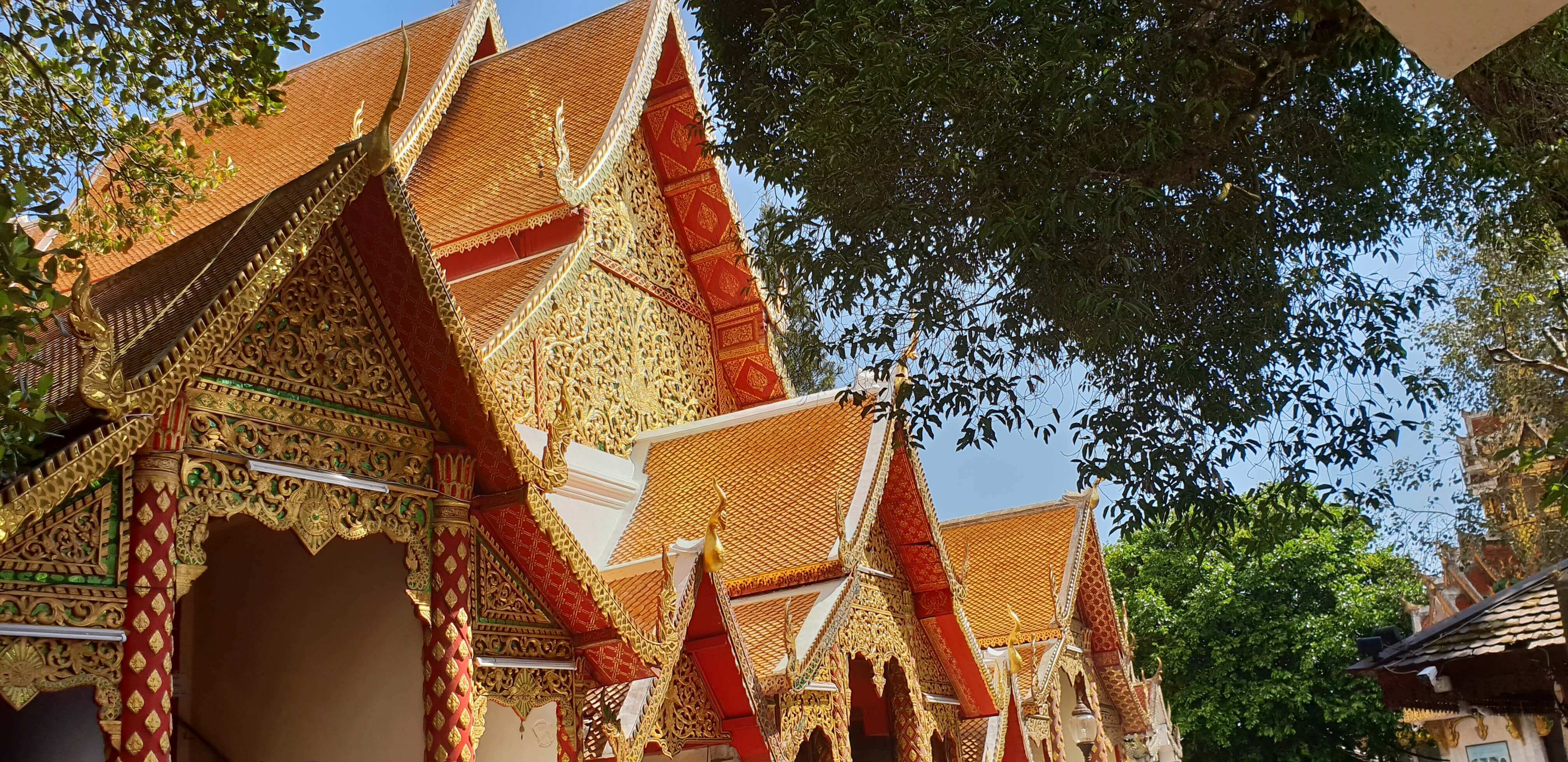
The sheer beauty and the rich religious history associated with the temple make it one of the best things to do in Chiang Mai. So make sure it’s right at the top of your Chiang Mai to do list.
NOTE – Wear appropriate clothes when entering the temple as a mark of respect for Thai culture. The temple does provide you with a sarong to cover yourself in case you’re wearing shorts.
2) VISIT THE BAI ORCHID AND BUTTERFLY FARM
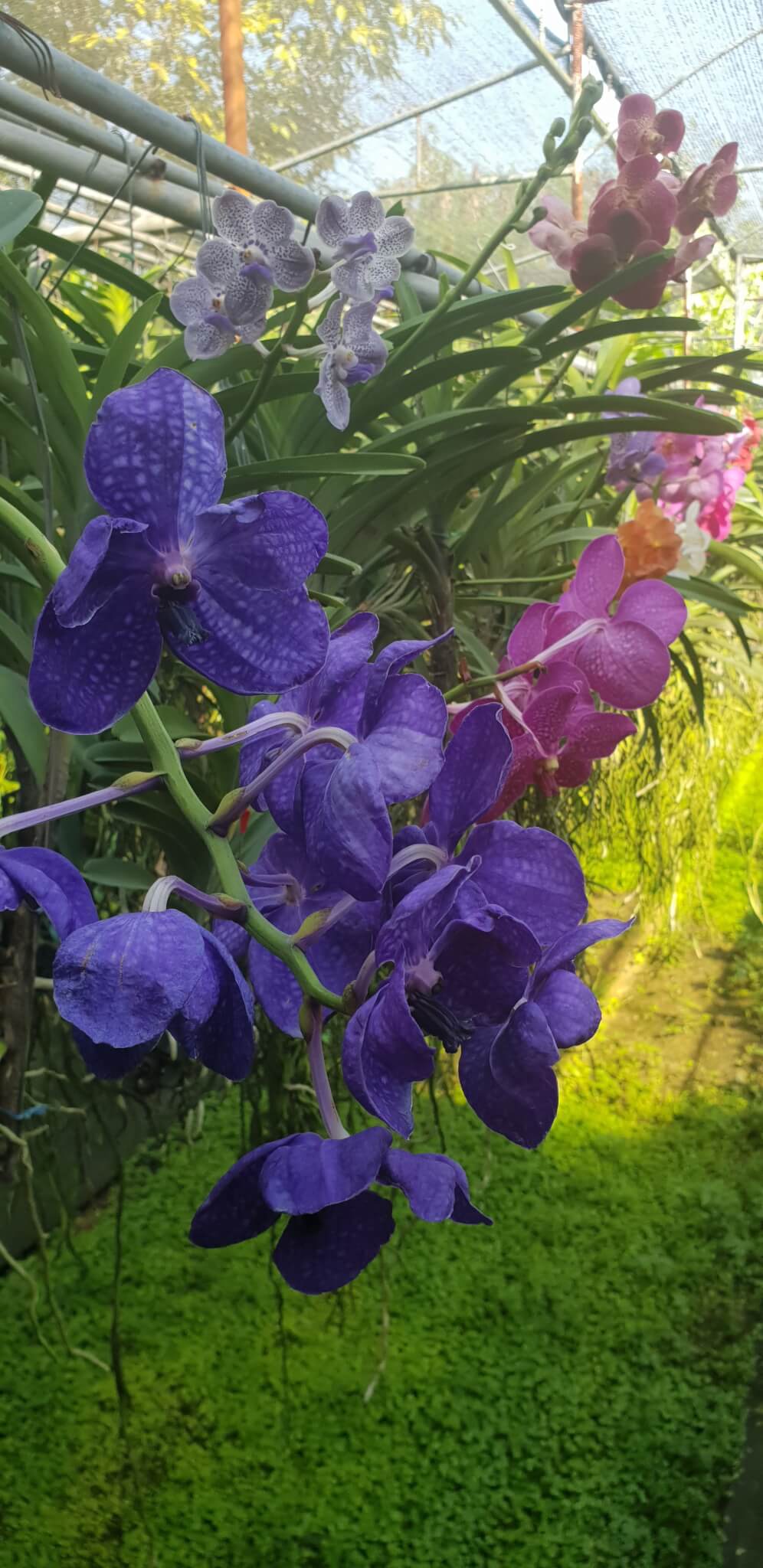
This Chiang Mai tourist spot comprises of two orchid gardens, a butterfly enclosure, a restaurant cum cafe and a showroom that consists of several gift/souvenir shops.
- Admission fee to the farm is 40 Baht per person and just as you enter the place, they pin a lovely orchid to your shirt as an “entrance ticket”. Walking towards the orchid gardens, you’ll see a small artificial waterfall flowing into a pond.
- The orchids are sheltered in a tropical setting with a wide variety of lush, colourful, beautiful and incredibly rare orchids displayed hanging. The splash of colours and the fragrance of the orchids create a pleasant enjoyable ambience.
- Inquisitive people will enjoy the background information they provide on the cultivation of orchids.
- Another section that I liked was the butterfly enclosure. Here you’ll find butterflies of different kinds flying all around you. It feels like the real-life implementation of a dream sequence in a movie. The best part is some of them calmly sit on the leaves and pose so that you can take some fantastic pictures.
- The coffees and milkshakes they serve in the cafe are deliciously refreshing. Do give them a try.
- If you’re hungry, then the buffet lunch they serve is just the kind of meal you’d enjoy. I won’t call it the healthiest meal because many items were deep fried but good lord were they tasty! Besides a delectable seafood spread, they have an elaborate vegetarian spread as well with dishes like Pad Thai, fried bananas, vegetarian tempura and Pad Ka Prao tofu being my personal favourites.
- The gift/souvenir stores sell you butterflies and orchids on rings, pendants, chains & earrings – all lacquered in gold.
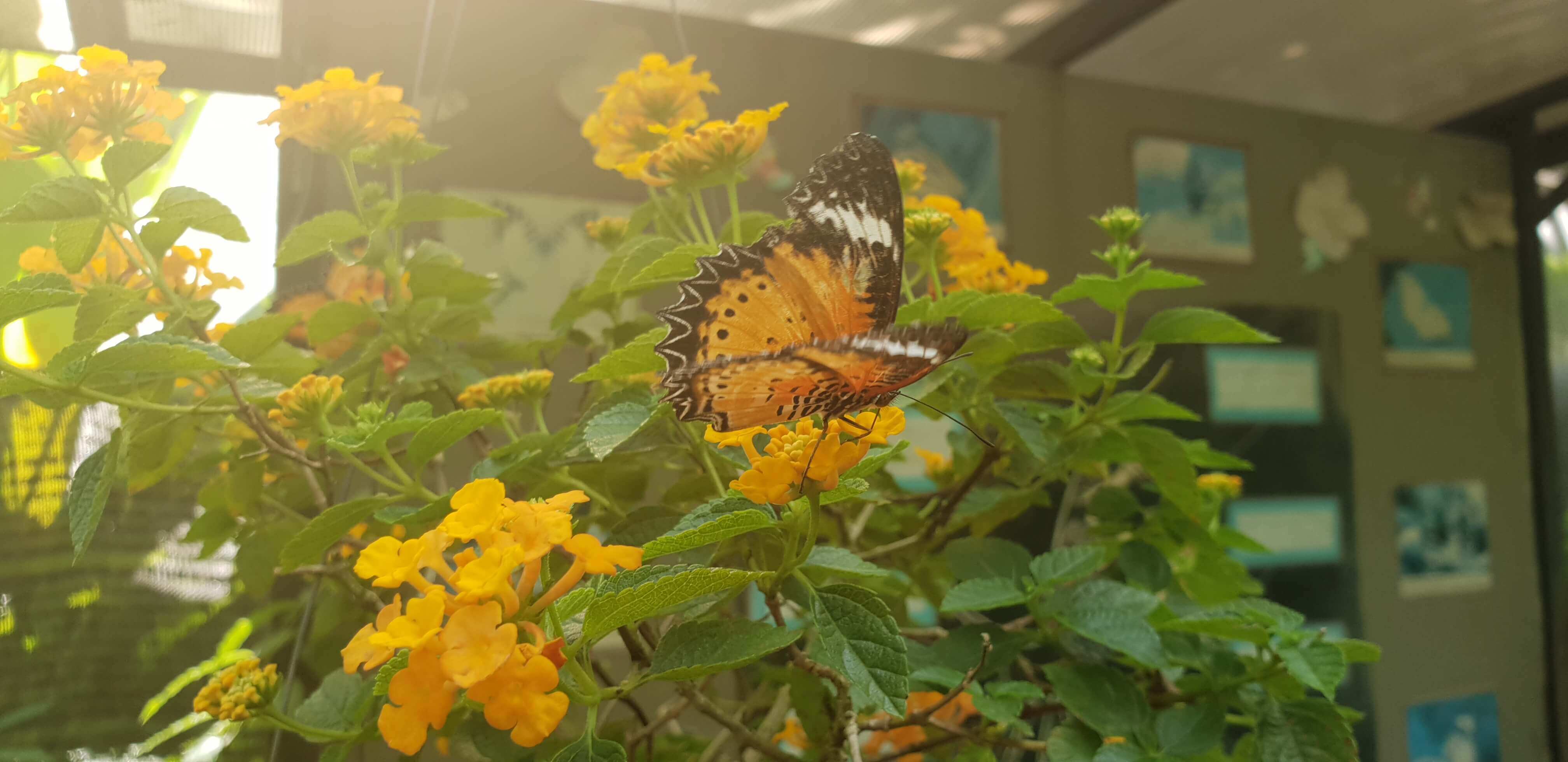
Visiting this farm is one of the coolest things to do in Chiang Mai and though this place didn’t feature in my travel plan initially, I’m glad I did it.
3) MEET THE VARIOUS TRIBES AT THE LONG NECK VILLAGE
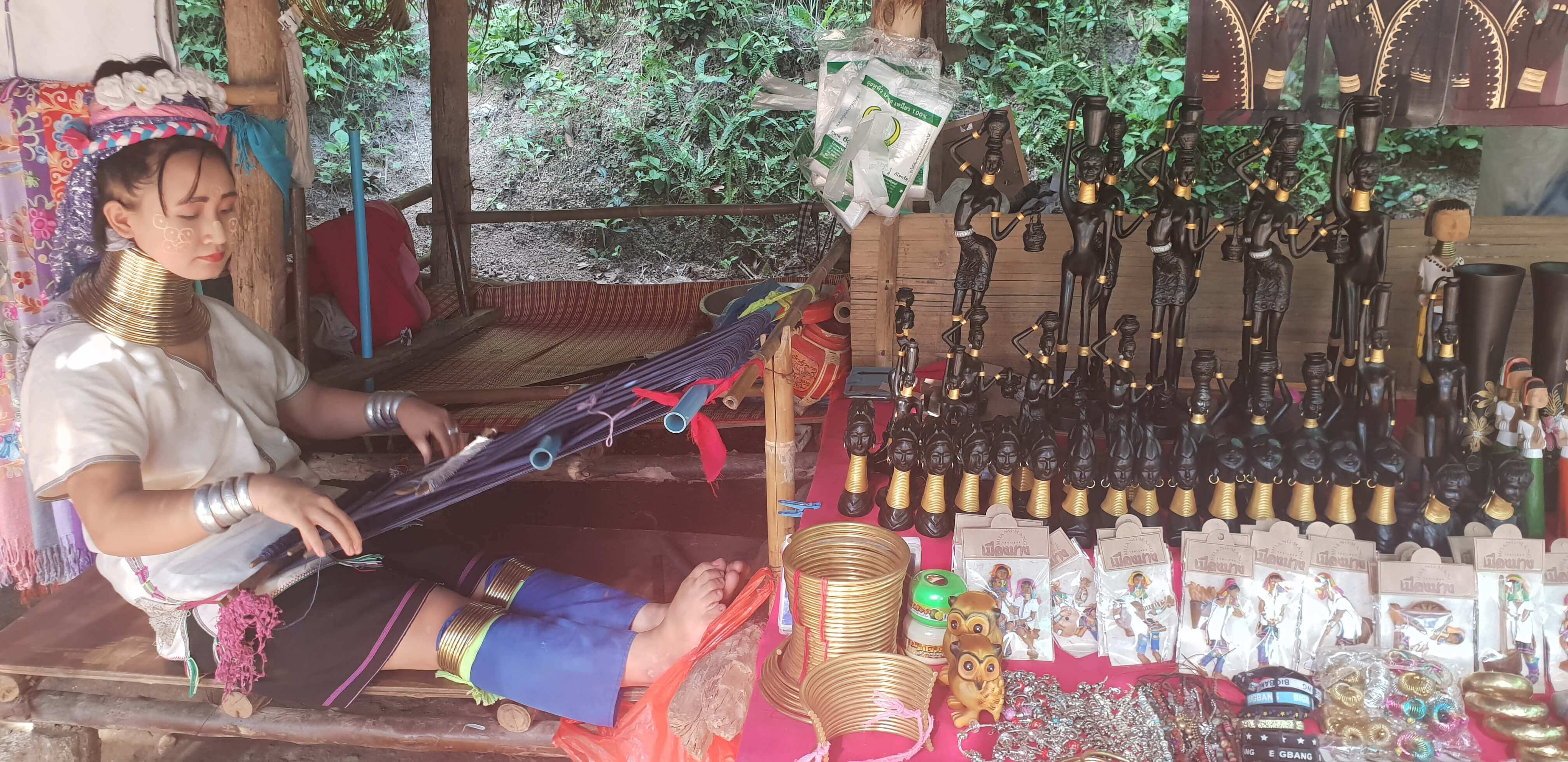
I have mixed feelings sharing this place with you. But I’ll get to explaining it first.
- The Long Neck Village is located in this place called Mae Hong Son. Entrance fee to the place is 250 Baht with 200 Baht going to the village and 50 Baht to the local body responsible for the village’s well-being.
- As you enter the village, firstly you’ll be greeted by smiling women from the Palong tribe. I found them a bit scary because of their black teeth but my guide explained to me that their teeth are black because they constantly chew betel leaves mixed with tree bark, tobacco and black lime.
- Then you’ll encounter people from the Akha hill tribe. You can identify them by their decorative headgear and a traditional colourful costume. Apparently, they still grow opium in the Golden Triangle (the area where borders of Thailand, Laos & Myanmar meet) and make most of their money through it.
- Finally, you see people from the Padong or Long neck Karen tribe. They smile at you and show you how they make beautifully handcrafted shawls. I was in awe looking at their necks, to be honest and I admit I wanted to visit the place just to actually see in person if they had such long necks and how did they go about doing their thing in everyday life.
- The women from the Karen tribe are basically women who moved from Burma to Thailand to escape the war conditions in their native country. The tribe’s famous for it’s women wearing golden rings around their necks. When they wanted to enter Thailand, the Thai government saw it as a business opportunity so it leased them land, clicked pictures of these ladies and marketed it on brochures as a tourist destination in Chiang Mai.
- The tourists started pouring in and the women were told to smile at tourists who’d pay money to see something ethically different and exotic.
- From the age of 5 till their 21st birthday, each year a ring is added to the neck of the women from this tribe. In the end, because of the rings constantly being on them, their neck actually elongates. Five-year-old girls, when initiated into this process feel a lot of pain but eventually it becomes a part of life for them.
- Interestingly, having a long neck is seen in their culture as a sign of beauty. The long neck signifies elegance and grace and is believed to protect them from predators as the predators first attack the neck of a creature.
- Unfortunately, they’re not allowed to leave their village and they’re supposed to stay on the land assigned to them. I feel bad for them but then if tourists didn’t go, then I wonder how would they make money that’d survive them and their families.
- The house stands divided on this one. However, I didn’t like the unethical torture of the women in the tribe and the fact that they were forced into this from a young age and not allowed to leave the village and live the lives of their choice.
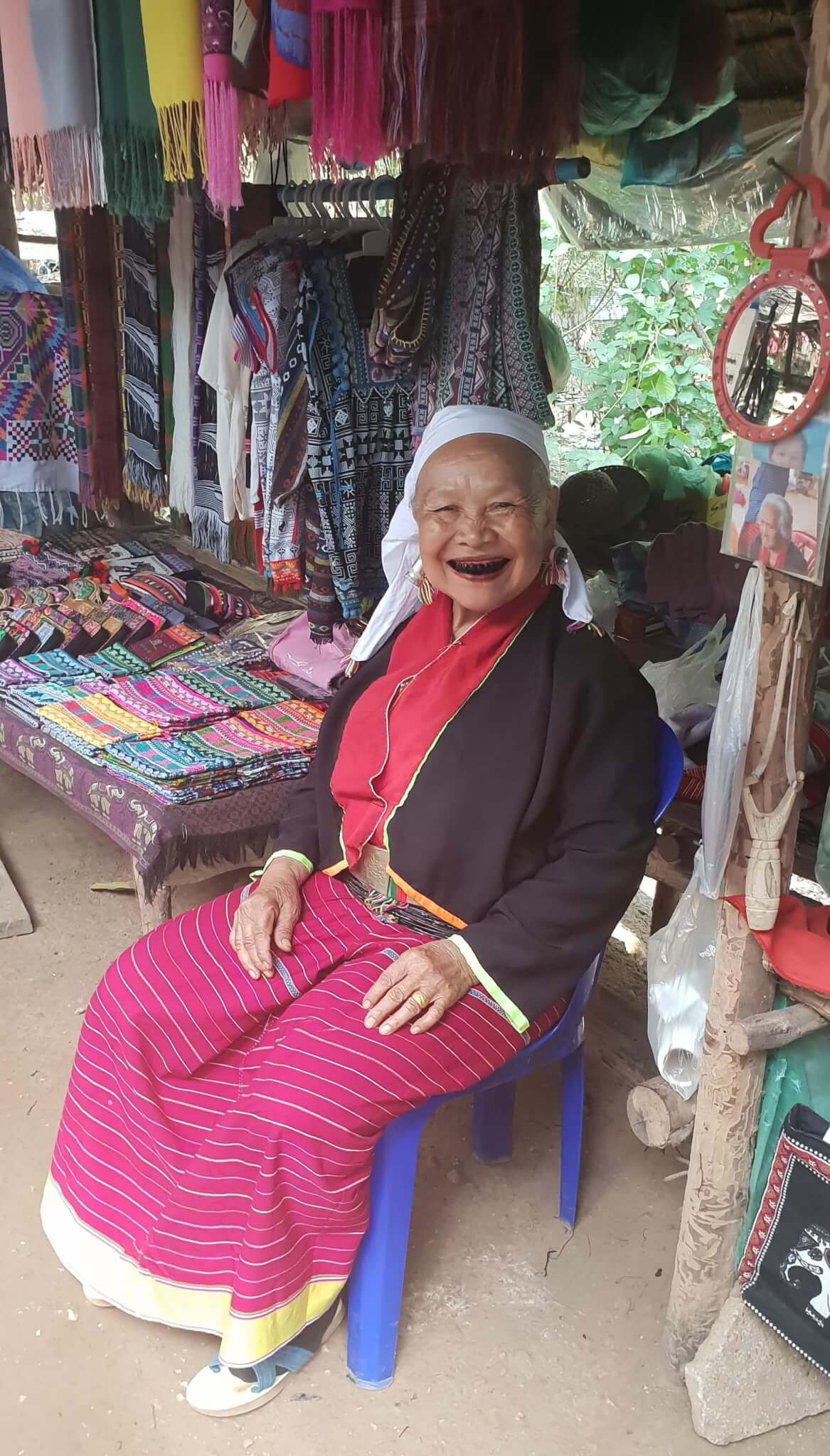
To summarize, the only advice I have for those reading this post is – visit the village if you want to, and support the tribe by purchasing their stuff but respect them as people and don’t force them to click pictures with you. You’ve purchased a ticket (to the village) and not the people living in that village. A bit of sensitivity would be appreciated.
4) SPEND TIME AT THE ELEPHANT POOPOOPAPER PARK
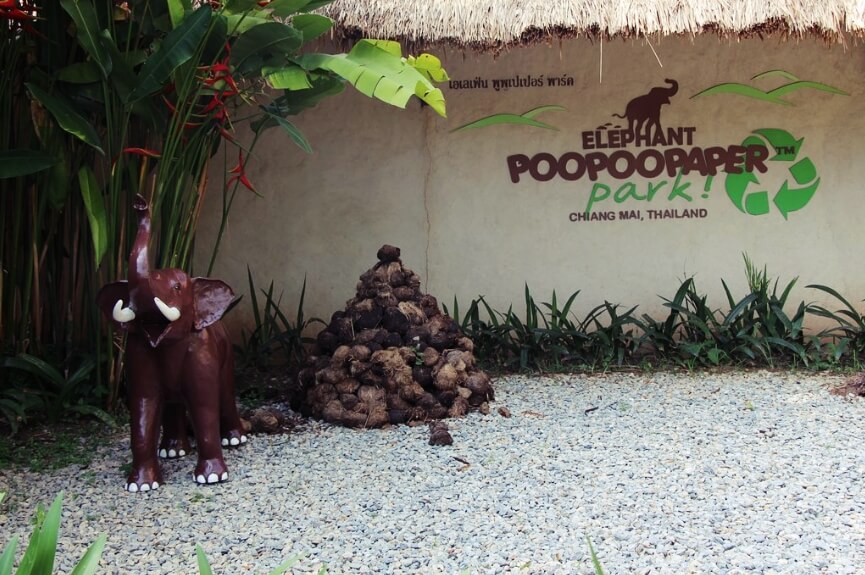
This is one of the most unusual places to visit in Chiang Mai and one that I recommend for it’s eccentric nature.
- It’s situated in Mae Rim near the Longneck tribe village and the admission fee to the park is 100 Baht. The fee includes a guided tour of the place, so no additional costs are involved.
- The place, as the name suggests, is an eco-friendly museum park that shows and explains how paper products are made from elephant poop fibres.
- You enter the place and see a POO-tique gift shop (told you, the puns are love) consisting of incredible products made from elephant poop. The place is set up amidst beautiful green surroundings.
- The guide is great and her interpretation of the process is funny and entertaining, to say the least. You are shown the whole papermaking process in which you too can join if you wish to. They recycle old poo paper to create new poo paper, therefore supporting the sustainability movement.
- The tour ends in the craft area where you can participate in the DIY (Do It Yourself) crafting and art activities. You can make greeting cards, bookmarks and decorate your journals. All items are reasonably priced. Take home unique gifts for family and friends and save trees while at it. I wish there were more places like these!
- There’s a cute Adobe cafe hangout in the park where you can try their “famous cookies” which I personally found a bit overrated. You’d rather try the smoothies at the place which are refreshing, tasty and filling.
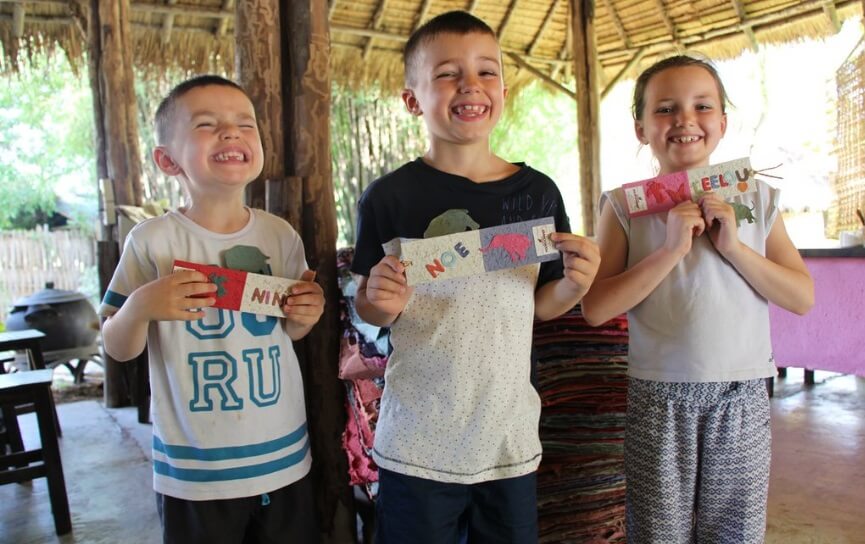
NOTE – I personally love this place and what it has to offer but only go there if you have an inclination towards poo puns, sustainability and elephants. Bleh! Just go there anyway and have a good time. It’s a Chiang Mai must see ft. Dj offbeat activities.
5) EXPLORE THE BO SANG UMBRELLA VILLAGE
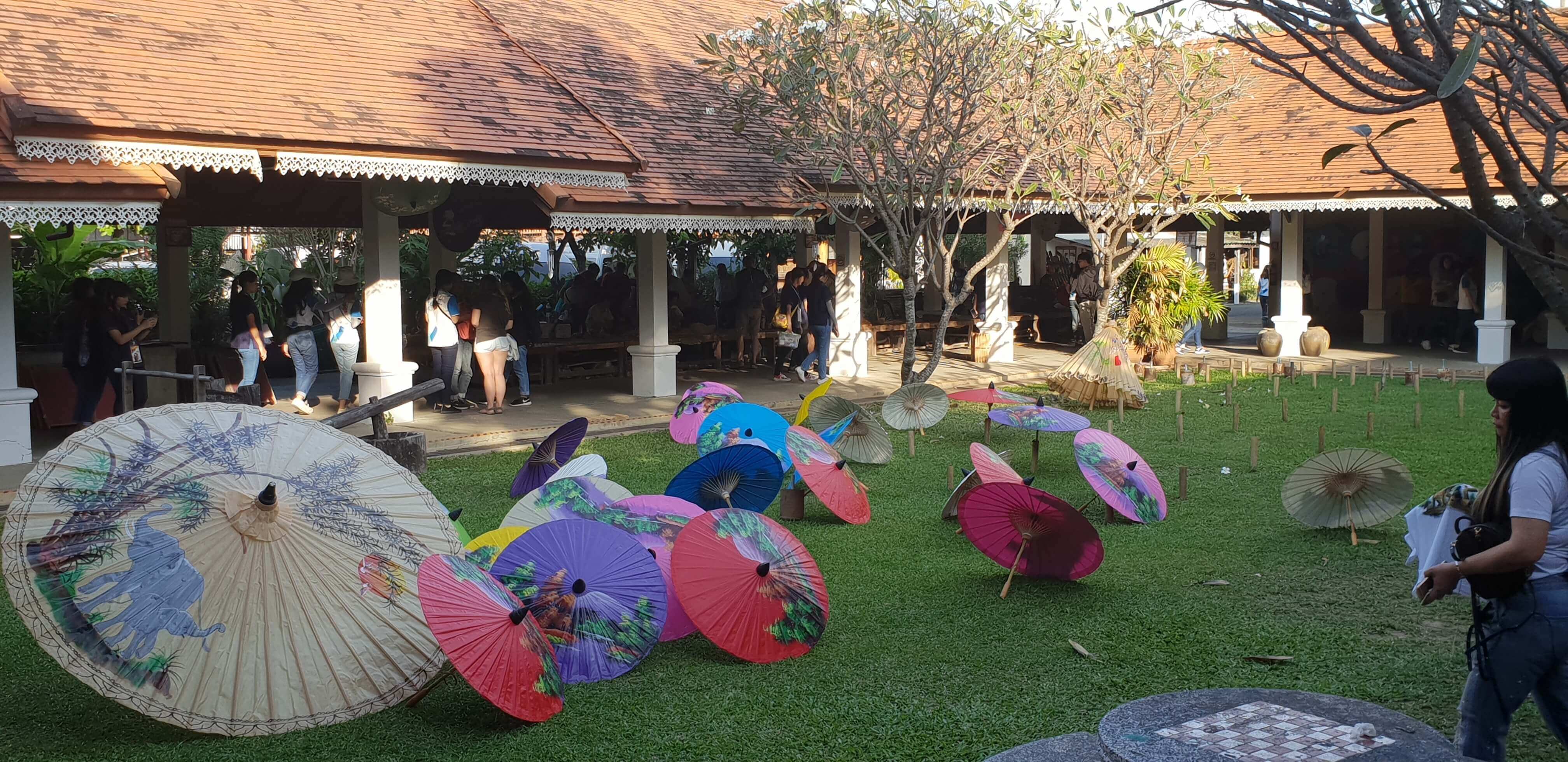
Just when you thought you’d seen all the artistry Chiang Mai has to offer, the Bo Sang Umbrella Village says “Hold my beer, bro!”
- It’s situated in the San Kamphaeng district and famous for producing handmade bamboo umbrellas and parasols.
- There’s an interesting story behind the place though. Bo Sang owes its umbrella heritage to this local monk named ‘Phra Inthaa’. He embarked on a trip to a monastery in Burma (now Myanmar) and there he was given a handmade paper umbrella to protect himself from the sun. He visited the village where the umbrellas were made and realised that Bo Sang had access to all the resources required to make these umbrellas.
- The monk thought that making these umbrellas would help the farmers in his village to supplement their income. So he educated himself with the techniques and skills involved, returned to his village of Bo Sang and taught the locals how to make these umbrellas.
- The place is a classic example of the traditional Thai craftsmanship as you see colourful umbrellas fill the place with their effervescence.
- Here you get to witness the entire process of making a traditional umbrella. The umbrellas are made from Sa paper produced from the Sa tree (also called the mulberry tree). There are information boards and guides to explain you each step of the process.
- From crafting the bamboo frames and tying it with thread to creating paper from the mulberry bark and painting the umbrella by hand, you’ll enjoy watching every bit of the hard work that goes into keeping this art form alive.
- There’s a huge souvenir store attached to the place that sells good quality umbrellas, fans, jewellery, clothes, ceramics, painted mulberry paper etc. at cheap prices. The products are authentic and the store, in my opinion, features some of the best things to buy in Chiang Mai.
- There’s also a cafe in the handicraft centre’s premises with a proper seating arrangement. Here you can grab a bite or enjoy some delicious milkshakes, smoothies and coffee.

NOTE: A must do before coming to this place is – to make sure you carry something with you that you want to have painted. They paint on wallets, jeans, mobiles, mobile covers, shirts, cameras, camera bags, backpacks, hands and what not!
6) SHOP AT THE NIGHT BAZAAR
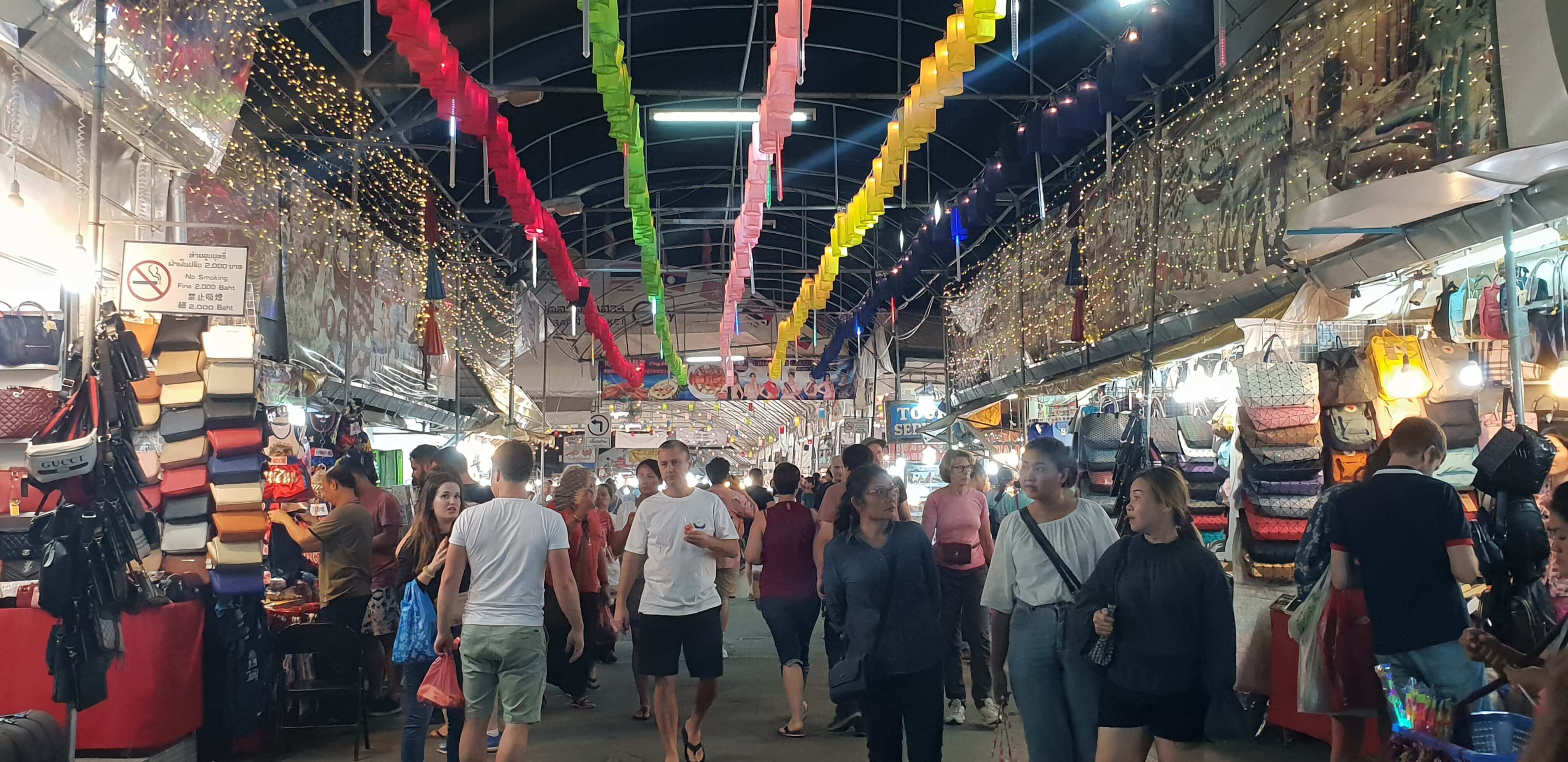
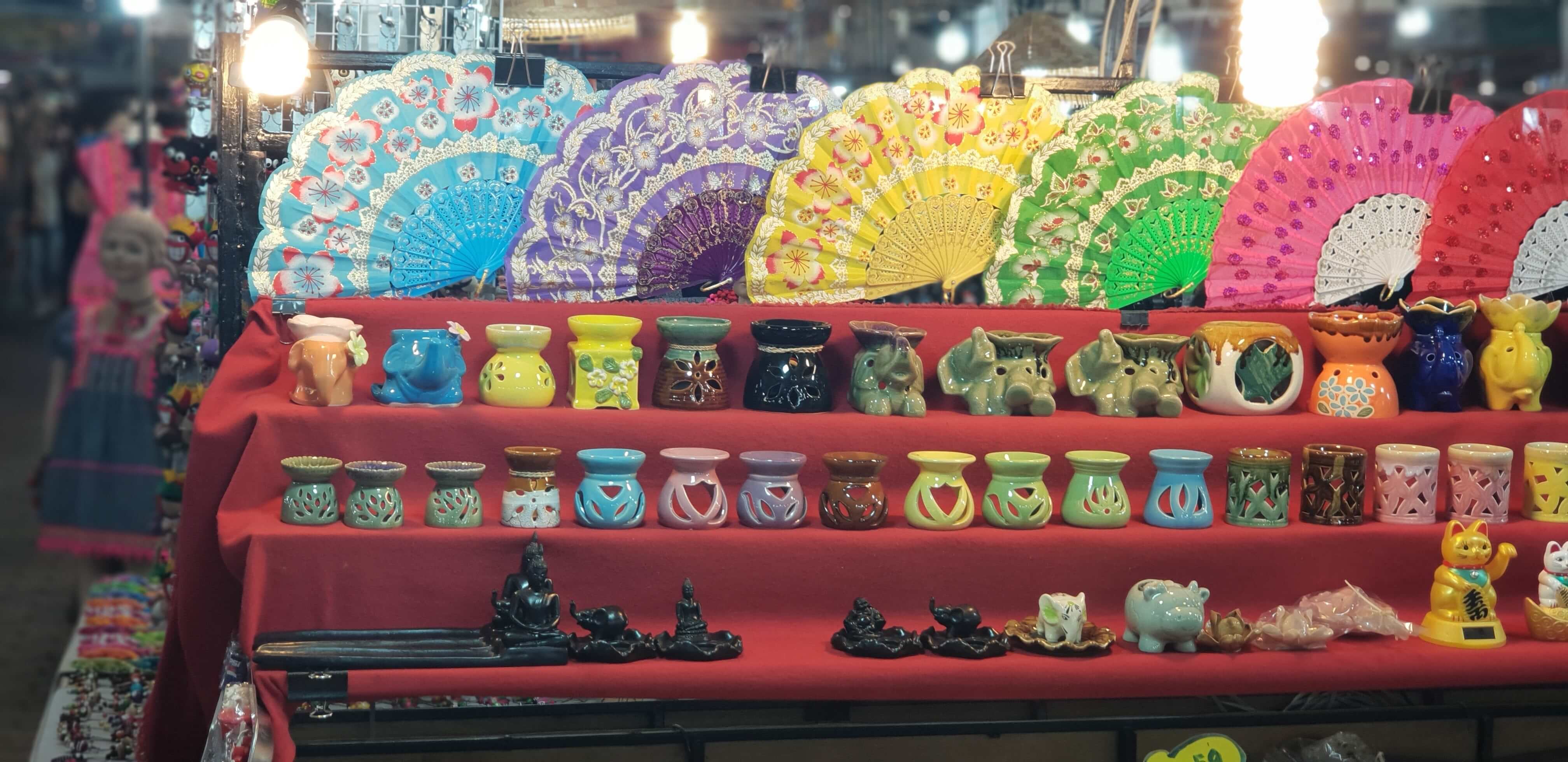
Night Bazaar is the beating heart of Chiang Mai and a place that’s not to be missed if cheap retail therapy & an energetic atmosphere excite you.
- Night Bazaar is a big wholesale market where you can buy souvenirs and local Thai handicrafts from local vendors.
- It’s a humongous commercial set up that sells everything that you can possibly imagine – clothes, purses, shoes, wallets, jewellery, belts, bags, cups, samurai swords, CD’s and DVD’s, furniture, watches, hats, caps, shawls, luggage, Thai silk, antiques, souvenirs, toys etc.
- If you’re hungry, then there are many eateries, cafes, restaurants and international outlets like Mc. Donalds, Subway & Starbucks to cater to your taste.
- Be patient and don’t buy the first thing that you see. Chances are that it’s available at a cheaper rate 10 steps away in another store.
- Stroll through the many alleys and arcades, enjoying the live music that’s blasting out from karaoke bars and sports pubs.
- When haggling with the Thai vendors, don’t get rude and personal. Keep it light and humorous with a smile on your face and 9 times out of 10 you’ll get the deal you want. Also, as a precaution, stay aware of your wallets, purses as there are many pickpockets roaming around the market.
- Address of the Night Bazaar: At the intersection of Tha Pae and Chang Klang Roads, Chang Klang, Chiang Mai 50100, Thailand
DAY 2 :
The things to do in Chiang Mai on the 2nd day are as follows :
- Spending time with the elephants and bamboo rafting at Maetaeng Elephant Park.
- Go ziplining at Zipline Chiang Mai
- Explore the temples in Chiang Mai old town – Wat Chedi Luang & Wat Phra Singh
- Enjoy the Night Safari
1) SPENDING TIME WITH THE ELEPHANTS AND BAMBOO RAFTING AT MAETAENG ELEPHANT PARK
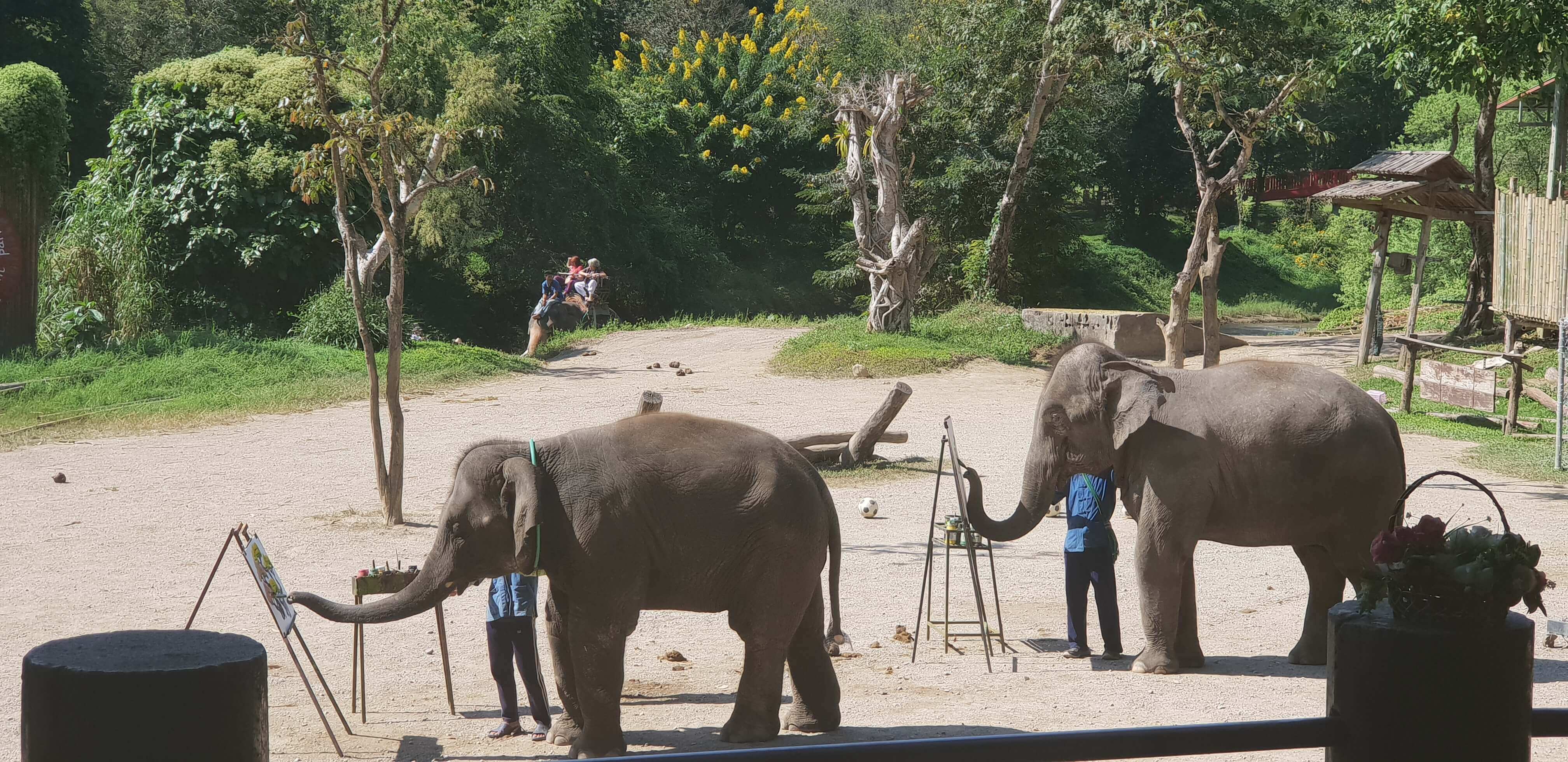
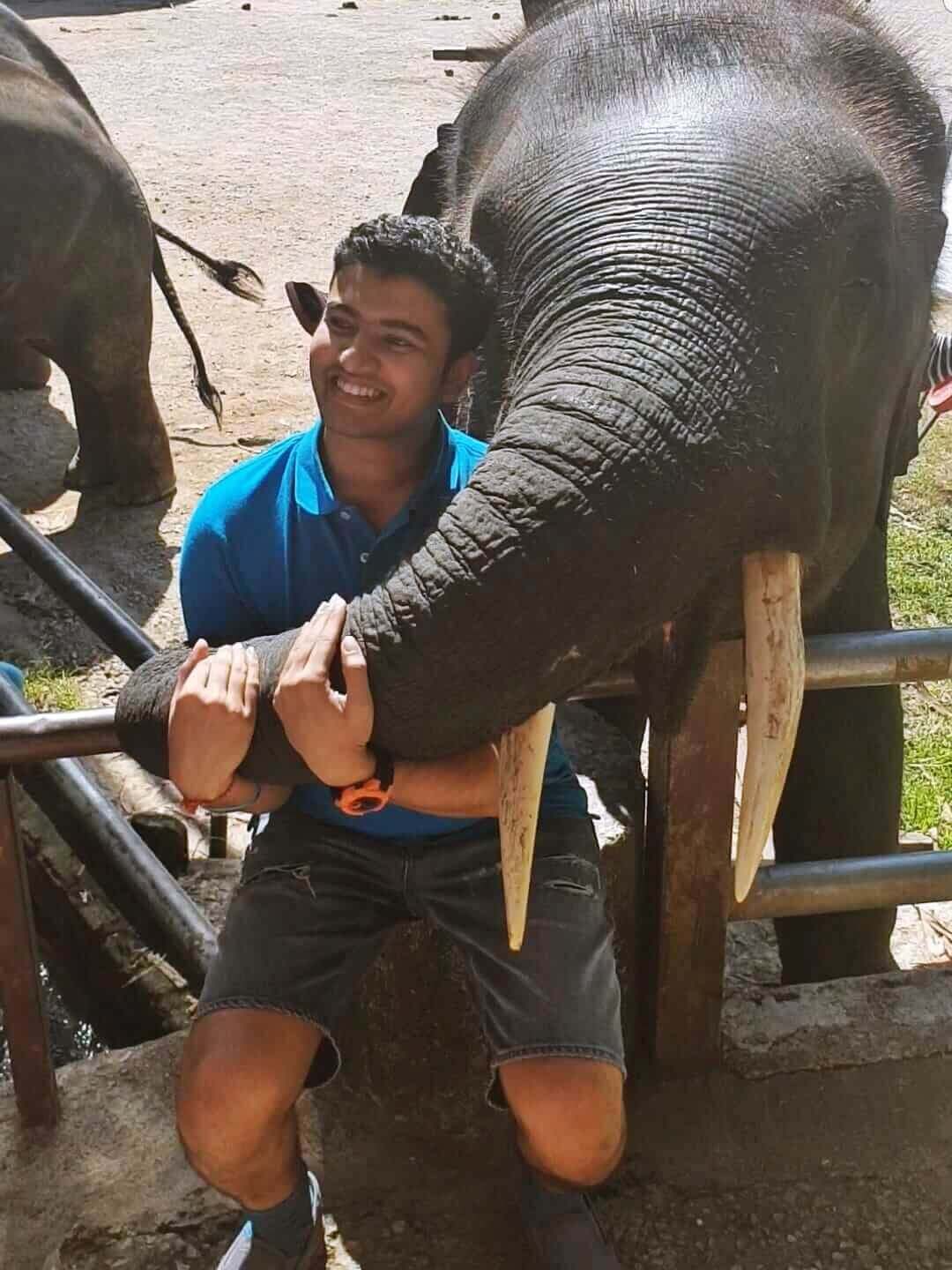
One of the fundamental things to do in Chiang Mai, Thailand is to spend time with the elephants. There are various elephant sanctuaries and camps in Chiang Mai that offer this experience. I had booked a package with an agency which chose the Maetaeng Elephant Park for us.
However, there were some things I liked and some that I didn’t like from my experience at the Park. I’ll share them with you and also provide you with an alternative so that you can make your own individual choice.
- Mae Taeng Elephant Park is located along the banks of the Maetaeng river in the Maetaman valley, 50 km away from Chiang Mai city. The Park runs a free elephant clinic to take care of the injured elephants and operates from the money that it earns from the visitors.
- The agency booked us a customized package which included an elephant show, an ox-cart ride, elephant trekking, bamboo rafting. You can book your package (with buffet lunch included) by clicking here.
- This is one of the places in Chiang Mai where you can see elephants and interact with them. Before the show starts, the elephants managed by mahouts (people who work with the elephants), interact with the visitors as part of the meet and greet. You can buy bananas and sugarcane from the counters in advance to feed the elephants post the show.
- Proceedings begin with the elephants performing a welcome march after which they put on an entertaining show. The show consists of elephants showing their football skills, taking free kicks and scoring goals. But my favourite part was the back kick where the elephant slightly shakes it’s tushy cutely to the side and kicks the ball behind. The elephants also show their basketball talents netting the ball into the basket.
- The show ends with the elephants exhibiting their painting skills as the elephants paint on a canvas board live in front of the audience. The most amazing part? Not only do they apply slow and precise strokes creating wonderful paintings but also autograph the paintings with their respective initials. The intelligence and creativity that the elephants show amazes and mesmerises you.
- After the show, you can take photographs with the elephants. Don’t forget to walk to the far end of the site and visit the elephant nursery. Here you’ll see adorable little elephants being fed, nurtured and taken care of. Most visitors usually miss this experience.
- The show is followed by an elephant ride and ox cart ride which my parents and I did not indulge in as we were not comfortable with it.
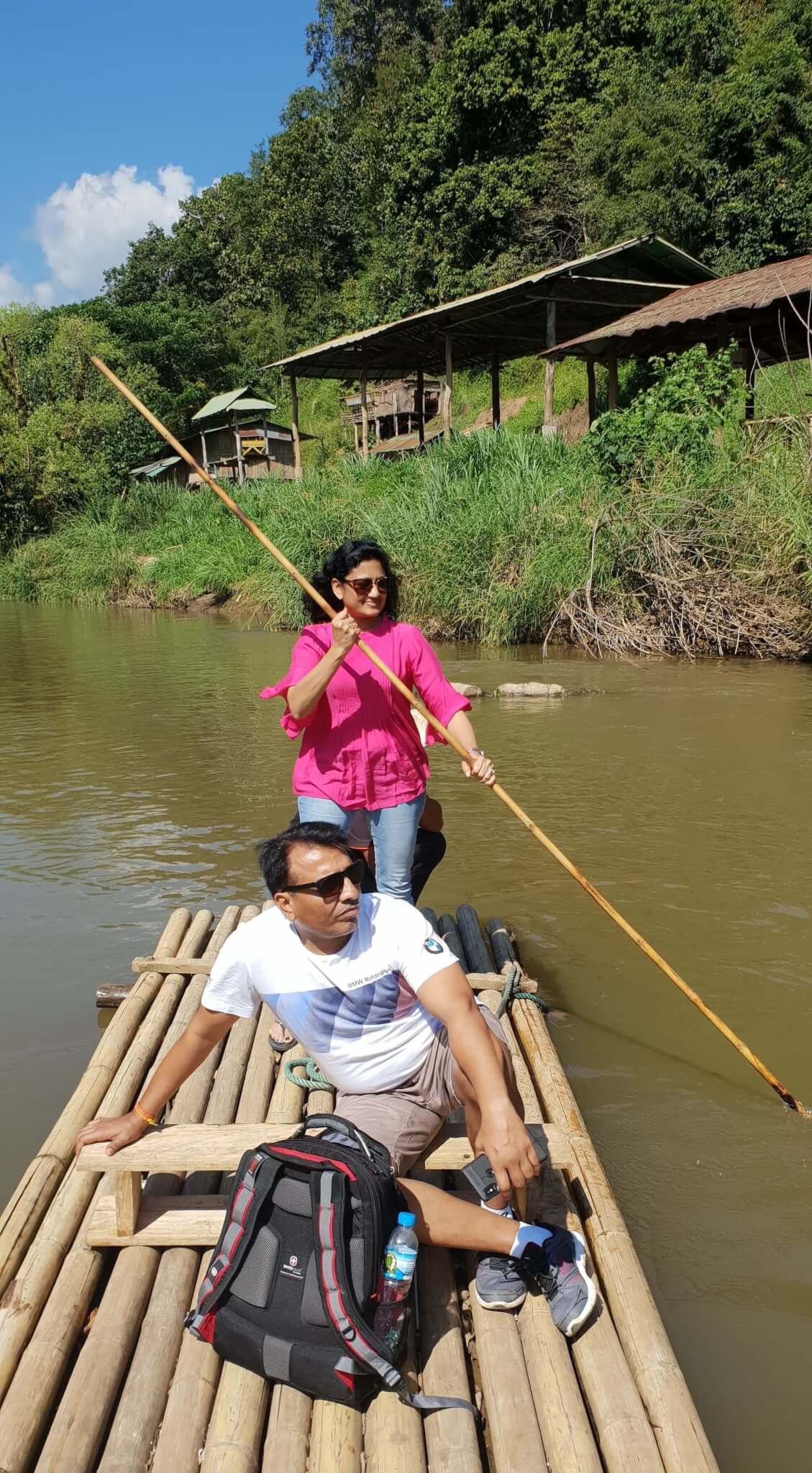
The tour ends with a 40-minute bamboo rafting experience which we thoroughly enjoyed.
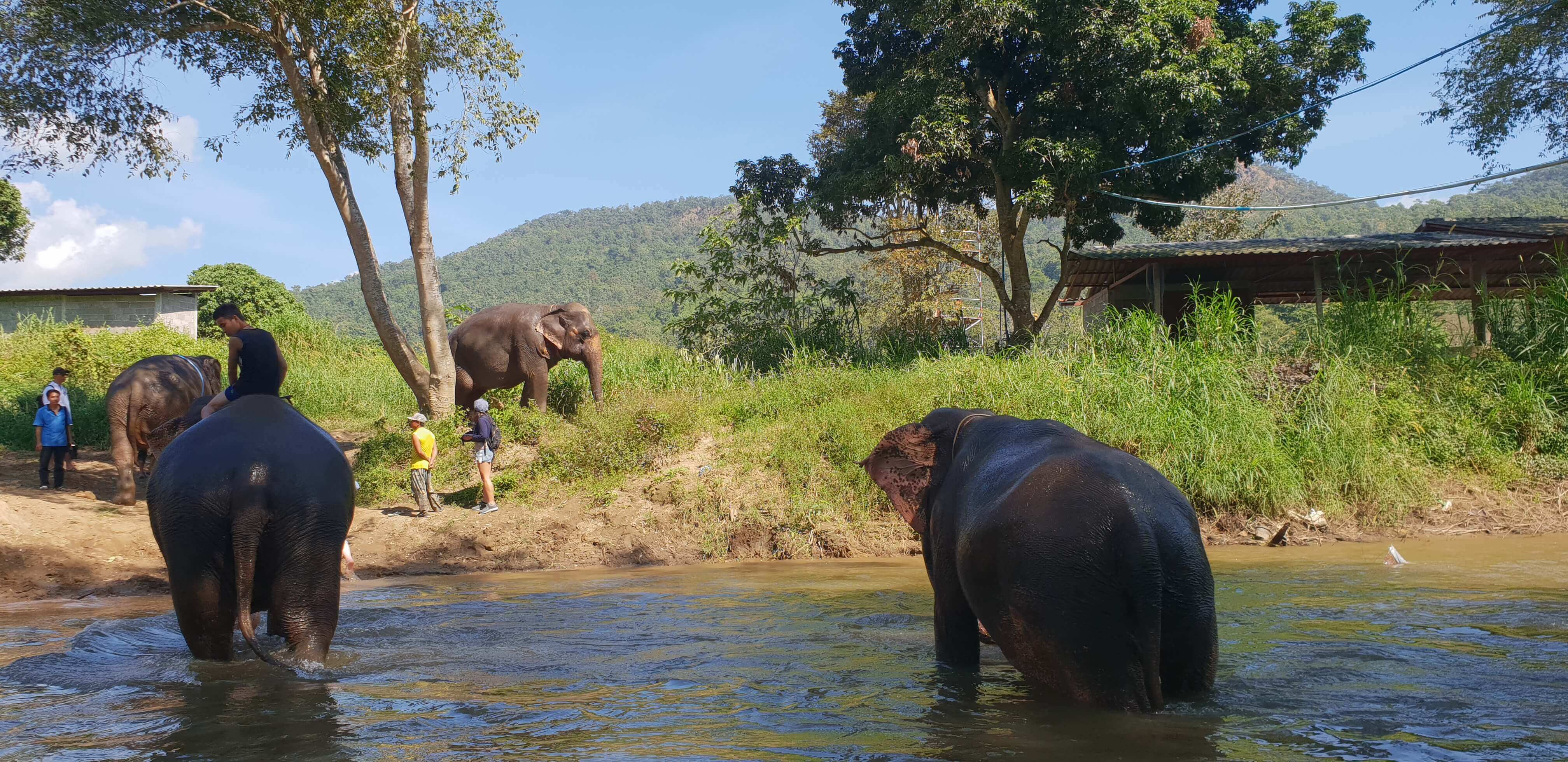
We even took turns guiding the bamboo raft ourselves and savoured the sight of elephants bathing in the river. There is a small (makeshift) supermarket stop during the ride for you to buy some snacks and drinks. Based on my experience with my family, I absolutely recommend bamboo rafting in Chiang Mai.
- In my opinion, the show is enjoyable and though it may have a circus-like feel to it (with an announcer at the helm of things) which might offend some people, the physical and mental dexterity of these amazing animals on display is worth appreciation.
- I did not like the elephant and ox cart ride part of the program and the fact that some elephants carry a leg chain and mahouts control the elephants with a bullhook. These were the negatives for me as far as this place is concerned. Rest of the experience was worth the money and enjoyable.
ALTERNATIVE OPTION – KANTA ELEPHANT SANCTUARY
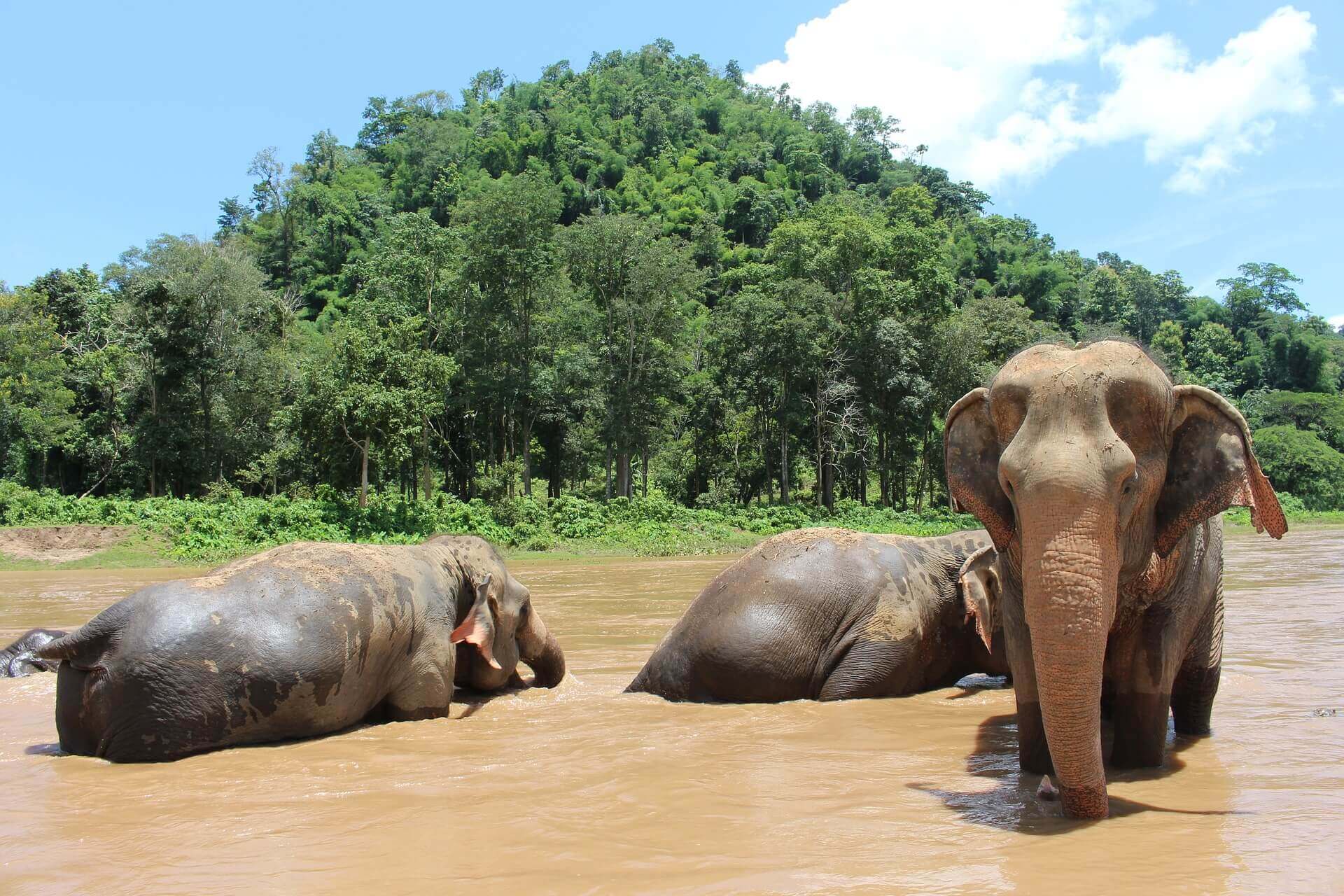
An alternative to the Maetaeng Elephant Park is the Kanta Elephant Sanctuary. It’s a one and a half hour drive from Chiang Mai city. Here you’ll find no hooks, no ankle chains and no riding on the elephants. You can look up their site and book an appropriate package by clicking here.
- There are about 15 elephants in this sanctuary and they roam freely as they please. Upon entering the sanctuary, the staff provides you suits to wear. You then feed bananas and sugarcane to the elephants and get to interact with the gentle giants.
- The guide here informs you about the history behind the sanctuary and how they take care of the elephants currently. They also tell you interesting things about elephant behaviour.
- You then get to prepare medicines for the elephants and feed it to them. Finally, you get to bathe the elephants which is the best part of the whole experience. You will get all muddy and wet but don’t worry as the staff provides you with clean towels for a shower. At the end of it all, they offer you fruits, biscuits, tea and (or) coffee.
- They have a photograph package for the photos they click of you with the elephants but they don’t hard sell and shove the packages down your throats. The photo package costs 400 Baht.
NOTE – Both the places – Maetaeng Elephant Park and Kanta Elephant Sanctuary offer you different kinds of experiences. Both were opened to save the elephants from the logging industry of Thailand and have succeeded in the same. So it’s upto you to decide as to what you’d enjoy more based on your understanding of ethical treatment and sensitivity.
2) GO ZIPLINING AT ZIPLINE CHIANG MAI
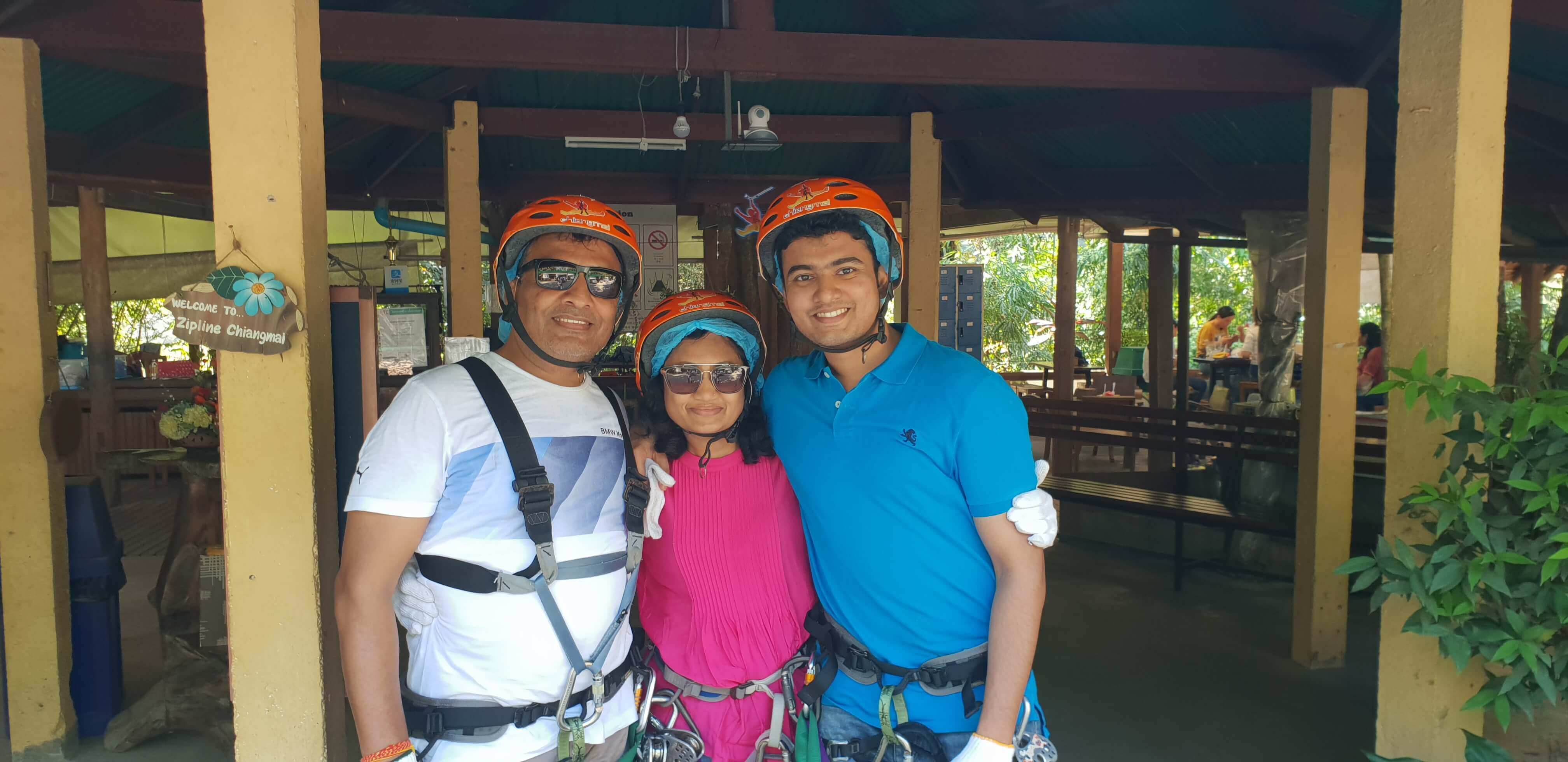
If the adventure junkie in you is craving an adventure in Chiang Mai, then I have just the activity you’d like. Ziplining with Zipline Chiang Mai was an unforgettable experience.
- Explore the tropical forest of Thailand enjoying an idyllic view of the Mae Taeng river as you fly from tree to tree.
- Zipline Chiang Mai is located at Baan Mae Tamaan, about 60 km from the city of Chiang Mai and near the famous Maetaeng Elephant Park.
- It offers you a 1-hour zipline experience as you cover a distance of 2.2 km covering 31 platforms along the way. The best part about this experience is that it’s an eco-friendly activity as none of the installations are harming any natural property.
- They charge 2000 Baht per person and the basic weight restriction they have is that the visitor should weigh no more than 260 lbs or 120 kg (approx.) Read the rest of the regulations by clicking here.
- I did the zip line with my 50+ year old parents and it was absolutely safe. Their safety standards are top notch and the guides speak good English. They teach you the basics in a sort of a rehearsal before the actual ride so you are well prepared and know what to expect.
- The guides are extremely friendly, helpful and ease your nerves with their sense of humour. You have to walk about 300m to get to the first zip line departure point. That’s the same distance you cover from the last departure point to reach the main reception area.
- The guides do the zip line with you. One of them reaches your next departure point before you to ensure that you have a safe ride to that point. You get a short break to have water after every zip line stretch you cover. All you got to do is listen to them and follow their instructions.
- My favourite part was the 400m dual zip line where you get to slide across the zip line with a partner. Just the feeling of you soaring over a stunning river with forest views on each side is an indescribable feeling.
- At the end of the zip line, they provide you with fruits, biscuits, cola, water and a cold wet wipe.
- Ziplining is one of the best adventure activities in Chiang Mai that you can do with your family/friends and I totally recommend you guys to try it.
NOTE: You can keep your valuables and cash in the separate individual lockers that they provide at the registration area. Make sure that your clothes aren’t too flowy or too tight and wear proper sports shoes for this activity.
3) EXPLORE THE TEMPLES IN CHIANG MAI OLD TOWN – WAT CHEDI LUANG AND WAT PHRA SINGH
The best things to see in Chiang Mai old town are it’s gorgeous temples. Two of the most worshipped and esteemed ones being Wat Chedi Luang & Wat Phra Singh.
a) WAT CHEDI LUANG
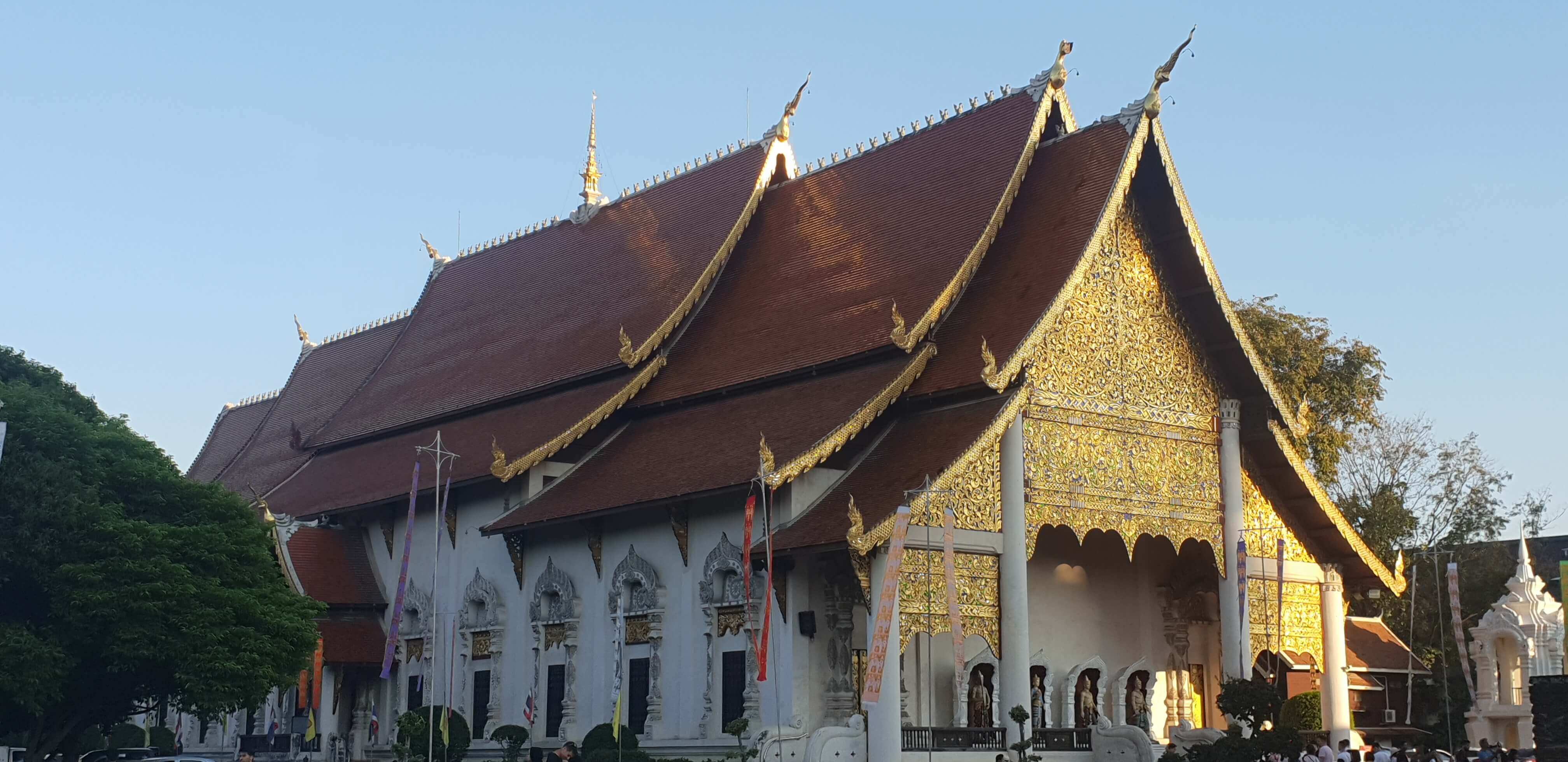
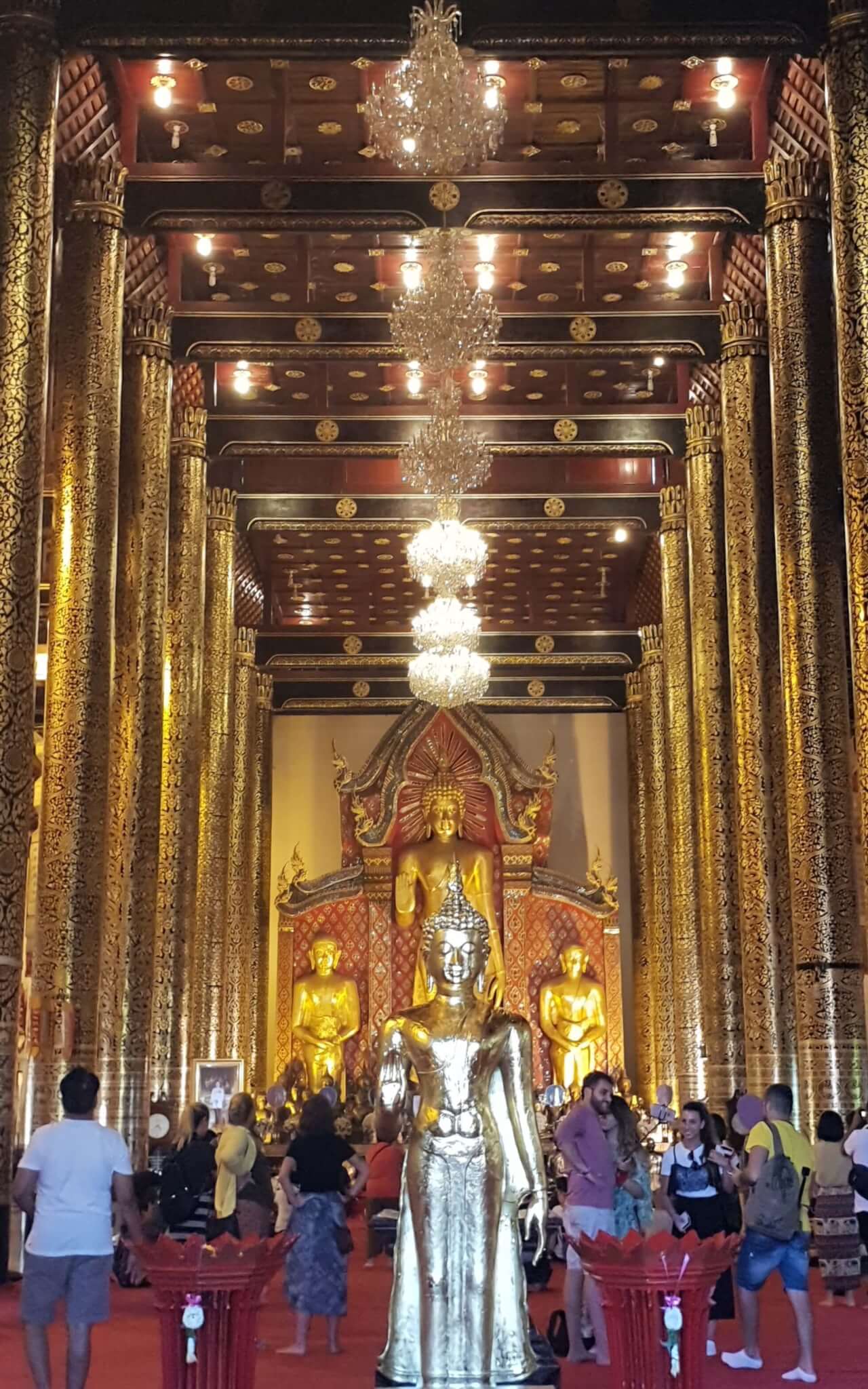
Wat Chedi Luang is one of the most attractive temples in Chiang Mai. Wat means temple, Chedi means stupa/pagoda and Luang means big/great so Wat Chedi Luang translates to Temple of the great stupa.
- It’s a Buddhist temple situated in the centre of Chiang Mai within the old walled part of the city. Entrance fee for the temple is 40 Baht per person.
- My guide Sam informed me that the temple was constructed in the 14th century by King Saen Muang Ma. However, the construction was completed only until the mid 15th century.
- It’s tall Chedi (pagoda) is the most noticeable feature of the temple. It is here that King Saen Muang Ma wanted to bury the ashes of his father. Upon completion of it’s construction, the chedi was 82m tall and measured 60m across the square base making it the largest structure in the Lanna kingdom of that time.
- The most sacred “Emerald Buddha” image was installed in the Wat Chedi Luang but an earthquake in 1545 caused a part of the pagoda to collapse and consequently, the Emerald Buddha was moved to Luang Prabang (present – Laos).
- In the main temple building or viharn, you’ll see a huge gold embellished Buddha statue. The tall pillars and royal chandeliers add to the grandeur of the temple. You experience a comforting feeling of peace inside the viharn.
- Walking outside this viharn, you’ll see the ruins of the once massive pagoda. Most parts of the architecturally impressive pagoda are still intact. Sunlight falling on the golden facade of the main viharn makes for a scintillating sight during sunset.
- Monk chat is another must-do activity at the temple. You can talk to several monks at the temple as they give you an interesting insight on Buddhist culture and their lives in modern society.
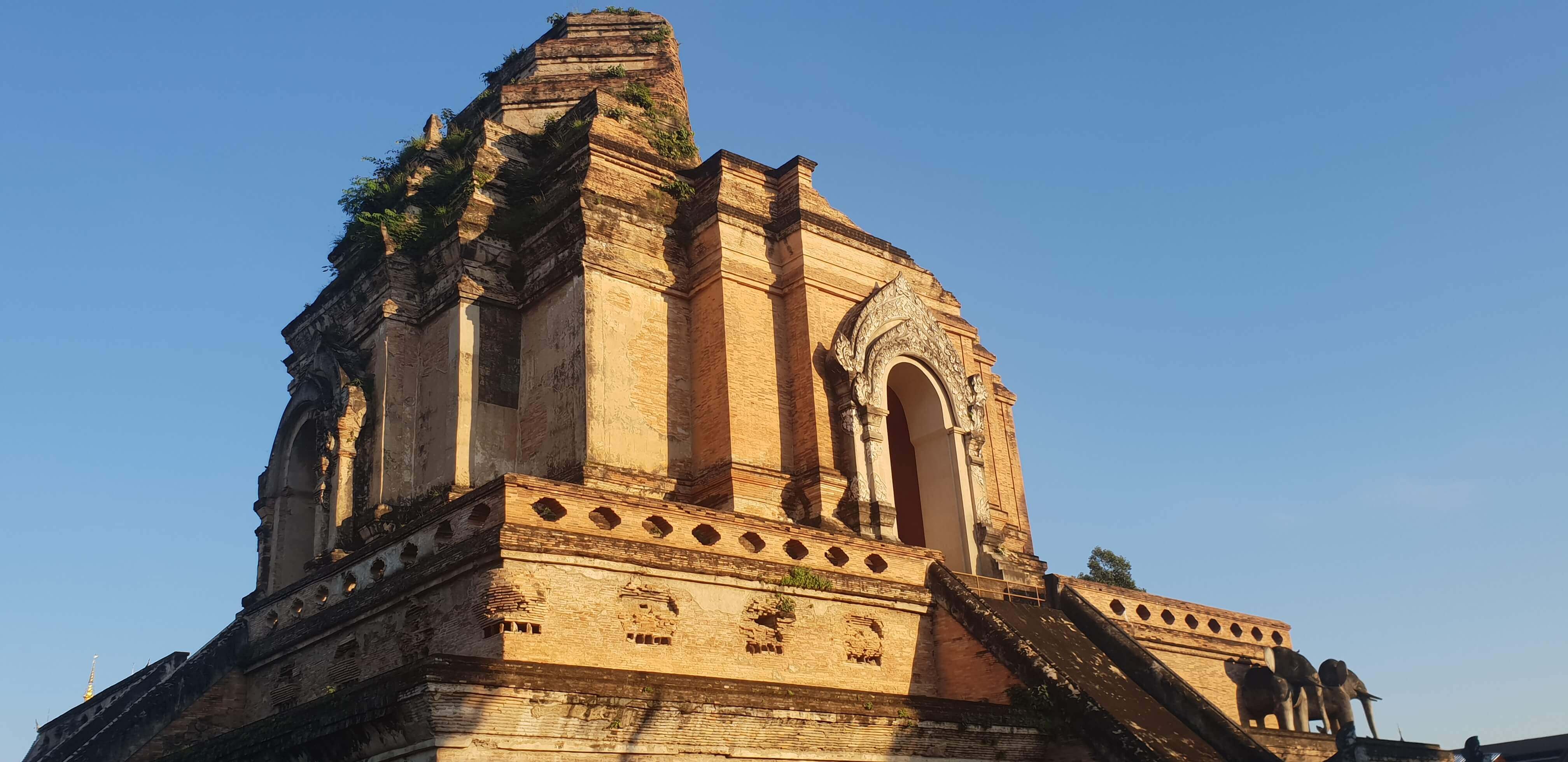
NOTE: Dress appropriately. Cover your knees and shoulders.
b) WAT PHRA SINGH
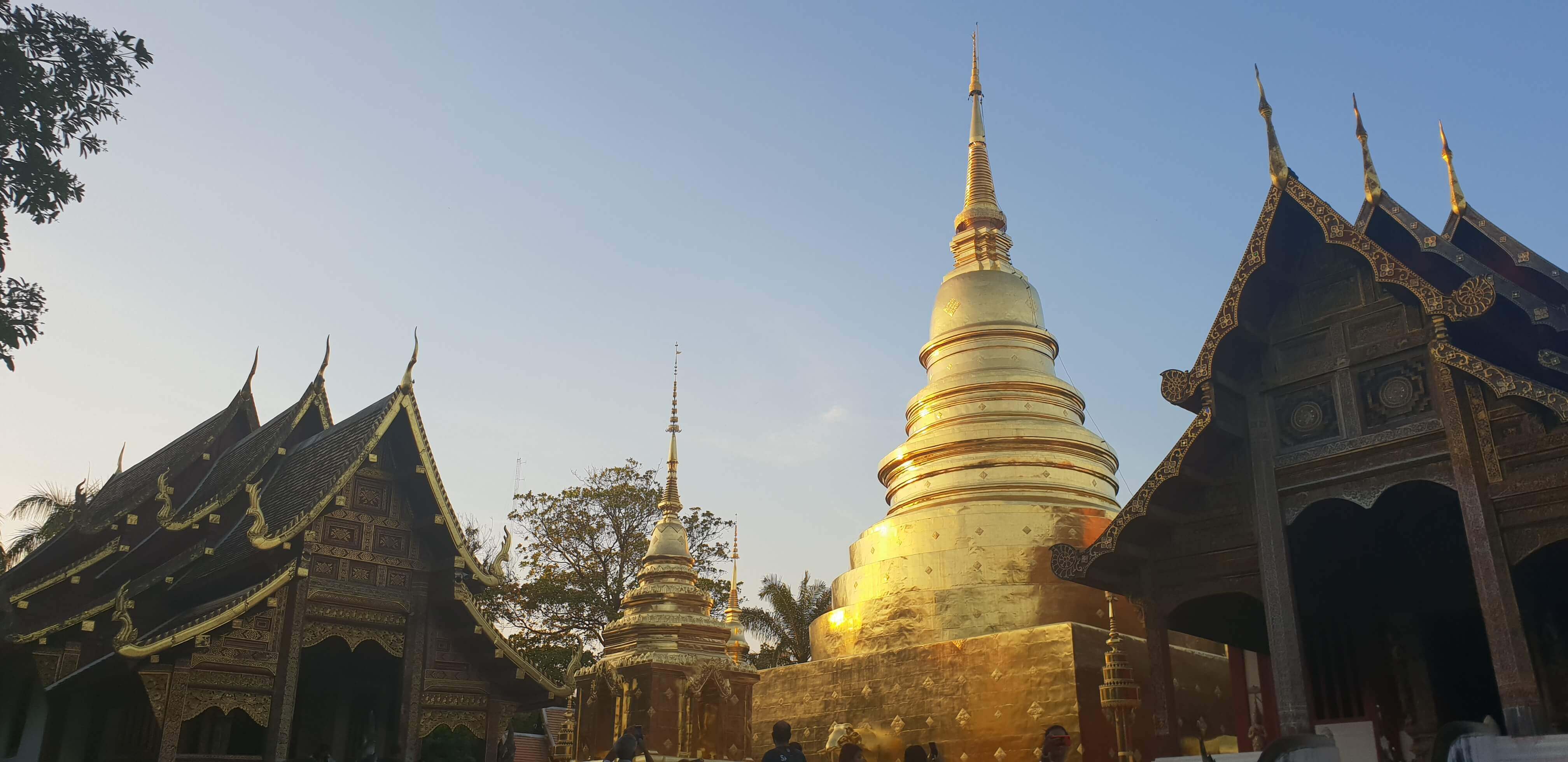
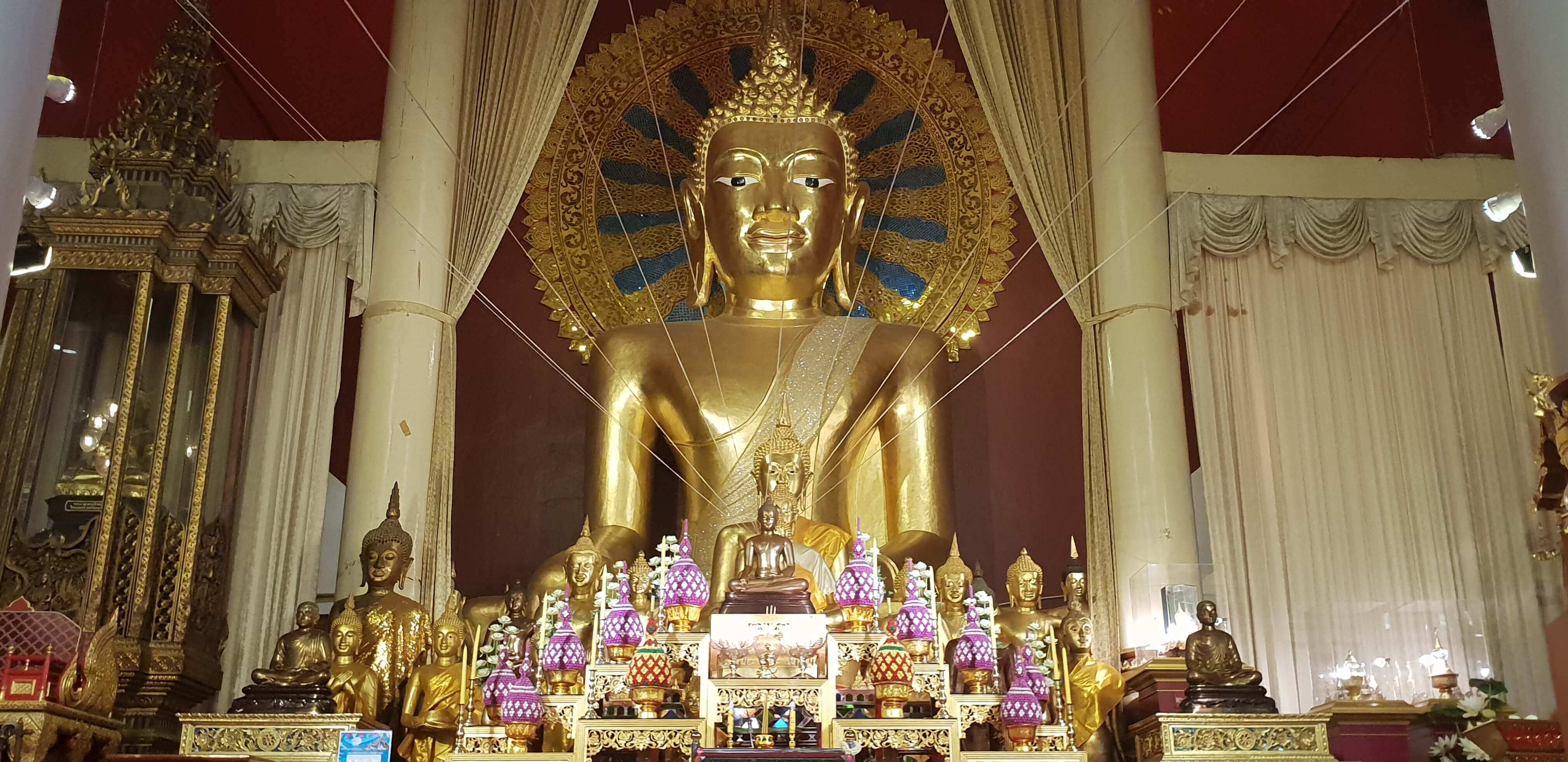
Wat Phra Singh is another one of the Chiang Mai points of interest that charms you with it’s exquisite beauty. It’s a short walk away from Wat Chedi Luang and the entrance fee for the temple is 40 Baht per person.
- I was told by Sam that the construction of this temple began in 1345 when a certain King Phayu from the Mangrai dynasty built the main Chedi (pagoda) to enshrine the ashes of his father King Kham Fu.
- Did you notice a pattern with both Wat Chedi Luang and Wat Phra Singh temples in the old town? Both were primarily built by kings to bury the ashes of their fathers. No wonder they have a sentimental value even today and occupy an important place in the Buddhist culture.
- The temple consists of three structures with the main attraction being the aesthetically decorated assembly hall or viharn called Lai Kam. It’s made from teak wood & is a typical example of Lanna style of architecture.
- Inside Lai Kam you’ll see the highly respected “Lion-like” image of Buddha called the Phra Singh from which the temple takes it’s name. Another striking feature of the viharn is the beautifully decorated wall murals depicting scenes from the lives of locals.
- To the left of the viharn Lai Kam is a library called Ho Trai inside which you can find Buddhist scriptures.
- The third structure is viharn Luang. It the bigger of the two assembly halls and situated right next to viharn Lai Kam. It houses a 15th century Buddha image made from copper and gold.
- However, what catches your attention are the lifelike wax figures of monks next to the Buddha image. For a few seconds, they actually fool you into believing that they are real people and not statues. Competition to Madame Tussauds? Hell yeah!
- Interestingly my guide Sam told me that this temple is the second most highly regarded temple after Wat Phra That Doi Suthep.
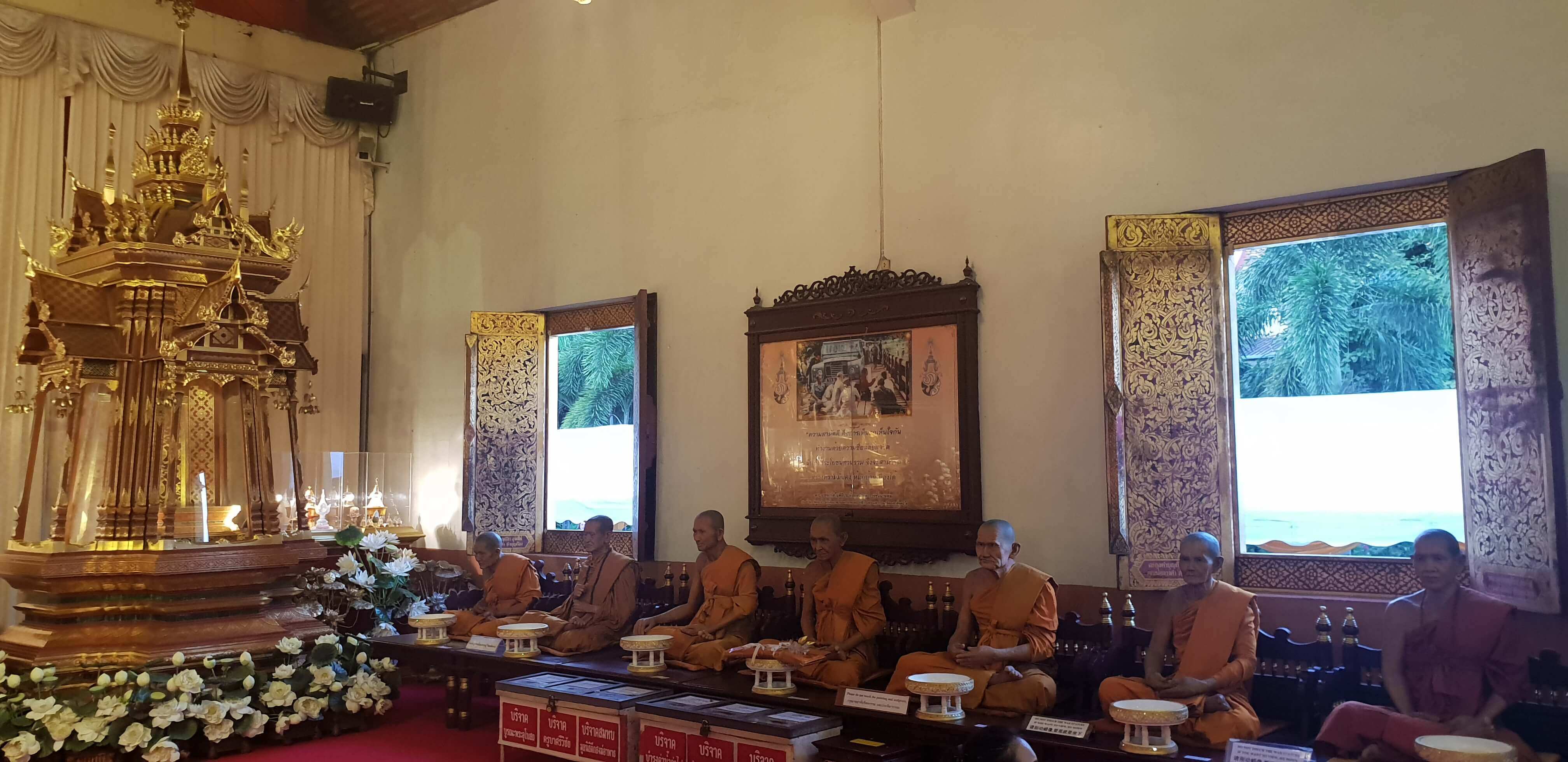
NOTE: Dress appropriately. Cover your knees and shoulders.
4) ENJOY THE NIGHT SAFARI
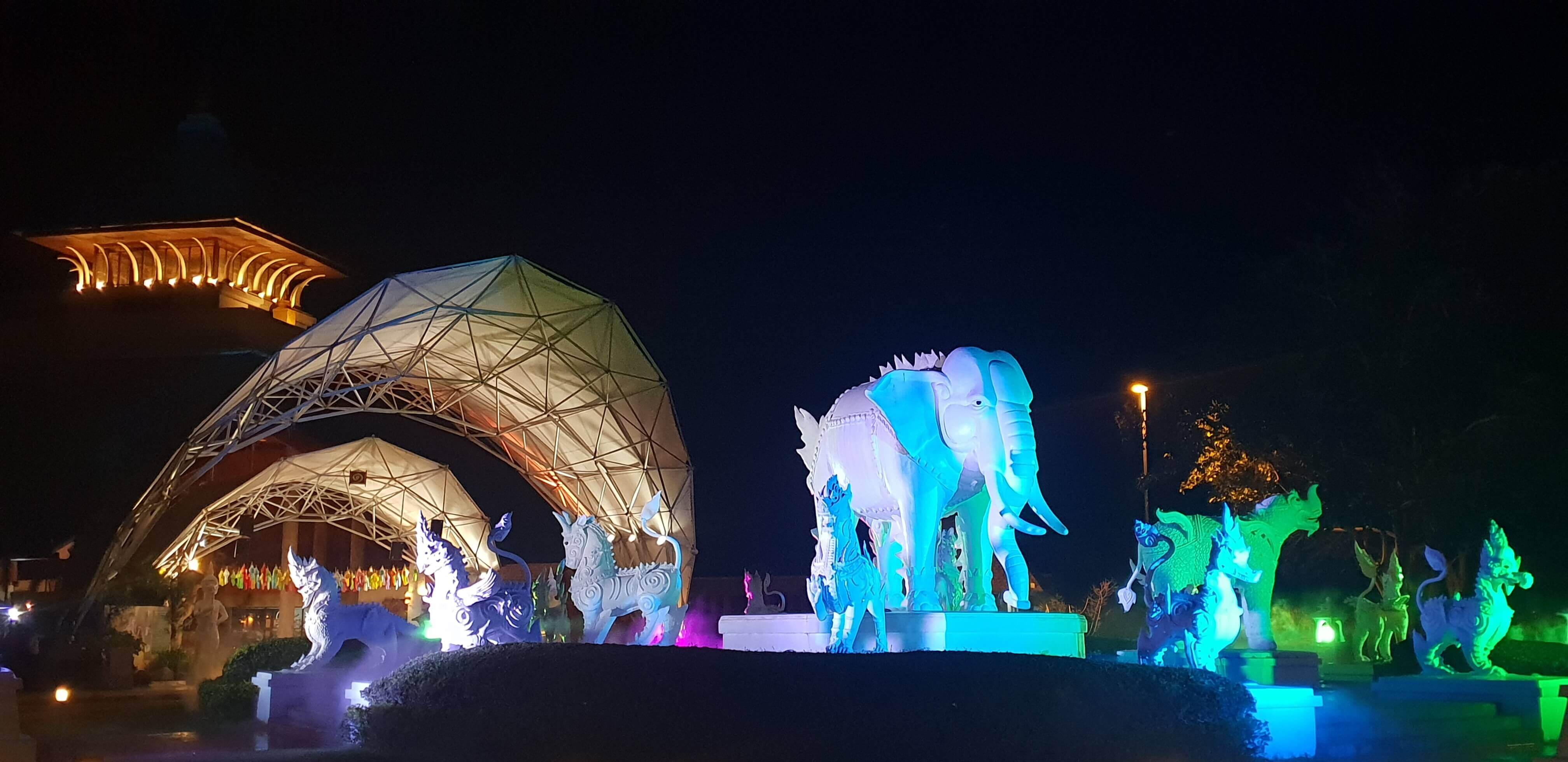
Doing the Chiang Mai night safari was an unplanned adventure and one that was worth it. Whether you’re a family with kids or just travelling solo, you’ll have a good time at this vocational study center working to conserve forests and protect wildlife.
Beware! You might be surprised by the deer walking freely in front of you as you enter the venue.
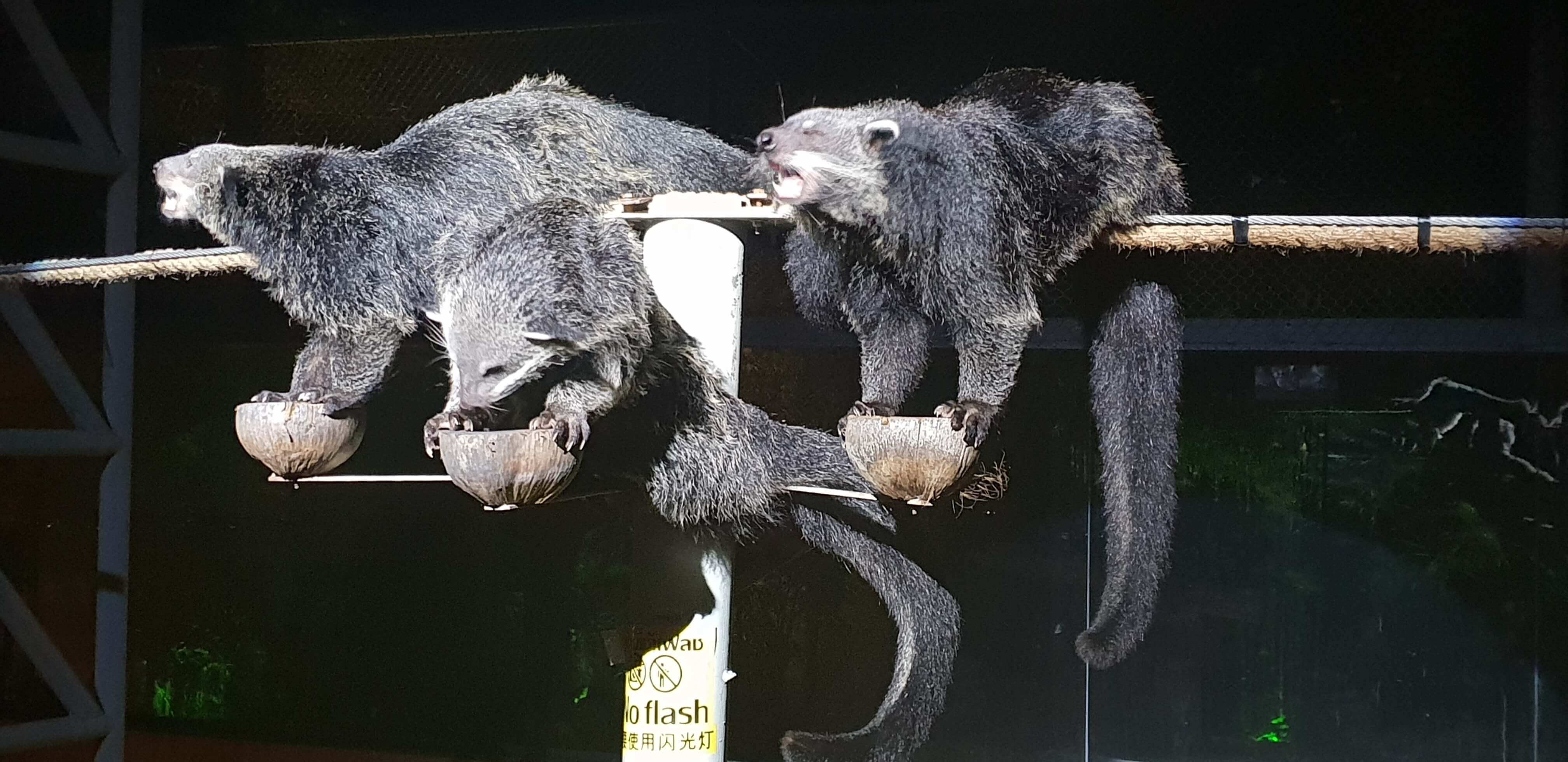
Entry fee for the Night Safari is 800 Baht for an adult and 400 Baht for a child. I’d suggest you check the showtimes and the language for the show (as shows in English have a specific time) before opting to go for the Safari. You can check the schedule of activities and the showtimes by clicking here.
- They also provide a free shuttle service that you can avail by clicking here.
- The Night Safari consists of two shows – Predator Prowl and Savanna Safari.
- In the Predator Prowl show, you are sitting in an amphitheatre styled seating watching predators enter the (guarded) stage in front of you one after the other. Animals like a porcupine, otto, wild boars, lion, hyena, white tiger and jaguar make synchronized entries to a pre-recorded voiceover that plays throughout the show.
- The highlight of the show was watching the jaguar and tiger swimming in what can be described as an aquarium style enclosure below the stage.
- In the second show ie. Savanna Safari, you are given a tram tour to various sections of the park, segregated on the basis of the territories that the animals hail from. An English speaking guide along with a driver who flashes the tram’s spotlight on the animal, helps you sight the animals in the dark.
- You get to see animals like gora, sero, american bison, shikha deer, antelopes, red kangaroos, emu, white rhino, Zebras, giraffes, cheetah, hyena, hippopotamus, asian elephant to name a few. Zebras and giraffes will even come close to the tram and say Hi!
- All in all, it was an enjoyable place to visit and one of the best things to do in Chiang Mai at night.
DAY 3 :
We do a day trip from Chiang Mai to one of the most popular and beautiful National Parks – the Doi Inthanon National Park. In this day trip, we explore the natural beauty of Chiang Mai cover the following –
- Mae Ya waterfall
- Wachirathan waterfall
- Trekking the Pha Dok Siew nature trail
- Twin Pagodas
- Hmong market
1) MAE YA WATERFALL
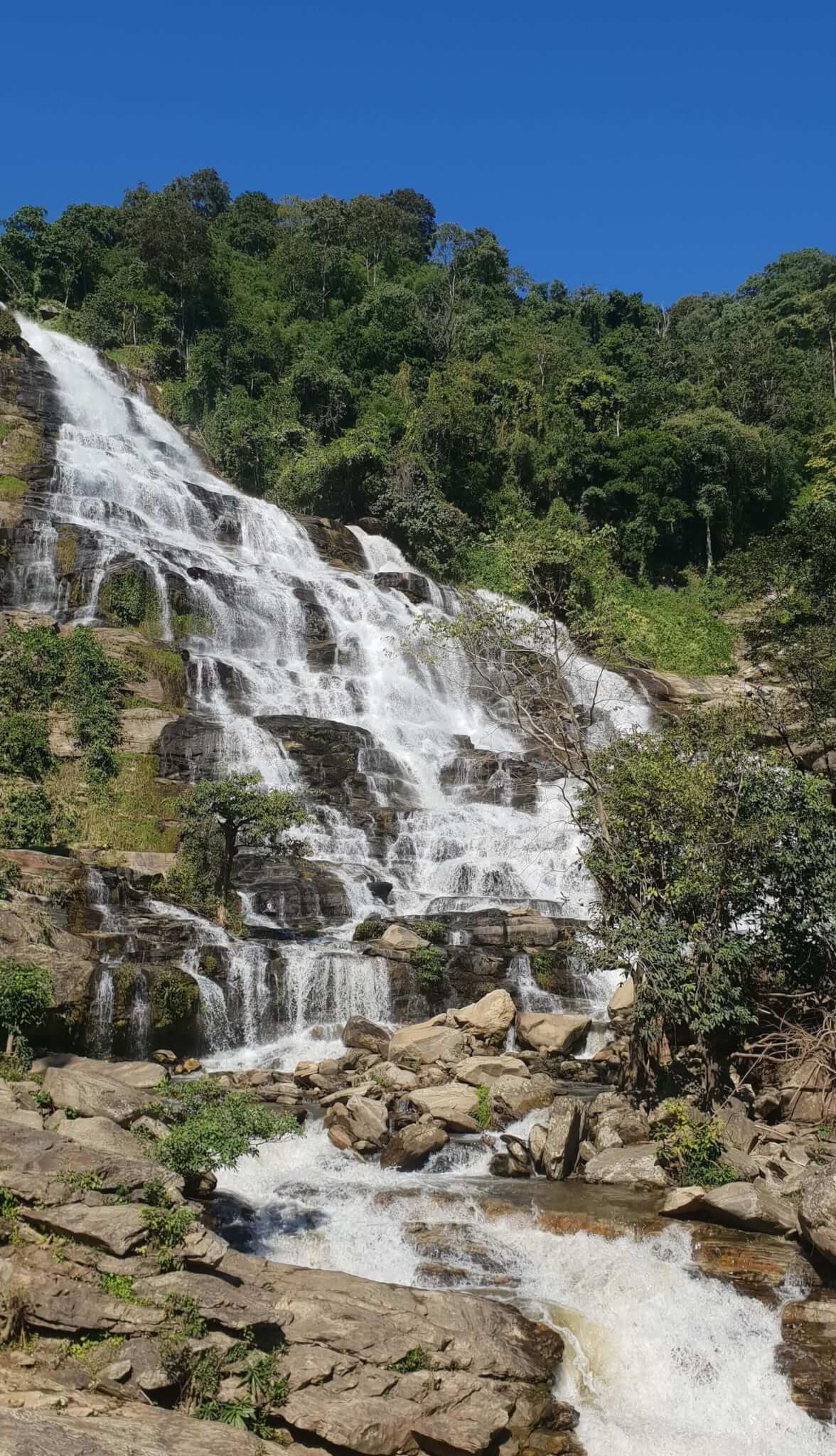
The first stop on Day 3 is one of the most beautiful and less visited (thankfully) waterfalls in Chiang Mai – the Mae Ya waterfall.
- Mae Ya waterfall is a 1 hour 15 minute drive from Chiang Mai city. It comes on the way to the Doi Inthanon National Park so it’s best to combine it with the trip.
- It’s situated in a park in Ban Luang in the Chom Thong district of Chiang Mai and holds the title of being not just the tallest waterfall in Chiang Mai but also one of the tallest waterfalls in Thailand.
- I recommend you to buy the Doi Inthanon National Park ticket in advance so you don’t have to pay a separate entrance fee for this waterfall as it’s included in the National park ticket. Doi Inthanon National Park ticket costs 300 Baht for an adult, 150 baht for a child.
- The waterfall is a 500m walk from the car park. The walk is comfortable and easy but it’s advisable to wear proper hiking/sports shoes as the area near the waterfall is slippery.
- Mae Ya waterfall stands 260m tall and 100m wide. It plunges down several tiers and appears like a silky white curtain while at it. The most accessible tier of the waterfall is 40-50m high and 100m wide. What makes this waterfall different from the others is it’s layered structure.
- The water flow is steady but not too powerful so it’s safe to go near it. We enjoyed our time at the waterfall relaxing on the rocks and soaking in it’s splendour. The layered waterfall surrounded by the lush green forests paints a scenic picture.
- The thing worth appreciation is that though not many tourists visit this place (as it’s off the beaten path), it’s still well maintained. There are separate toilets built near the waterfall and they are sparkling clean.
- On exiting the park, you’ll notice small food stalls selling coconut water, strawberries, boiled & peeled coconut and sesame seed garnished groundnuts. Do try the groundnuts and the strangely peeled boiled coconut water.
- Mae Ya is the most underrated waterfall and rarely finds a spot in the Chiang Mai tourist map. The fact that we had the entire park to ourselves speaks volumes about it’s exclusivity. Do visit this waterfall in Chiang Mai if you have time on your hands.
2) WACHIRATHAN WATERFALL
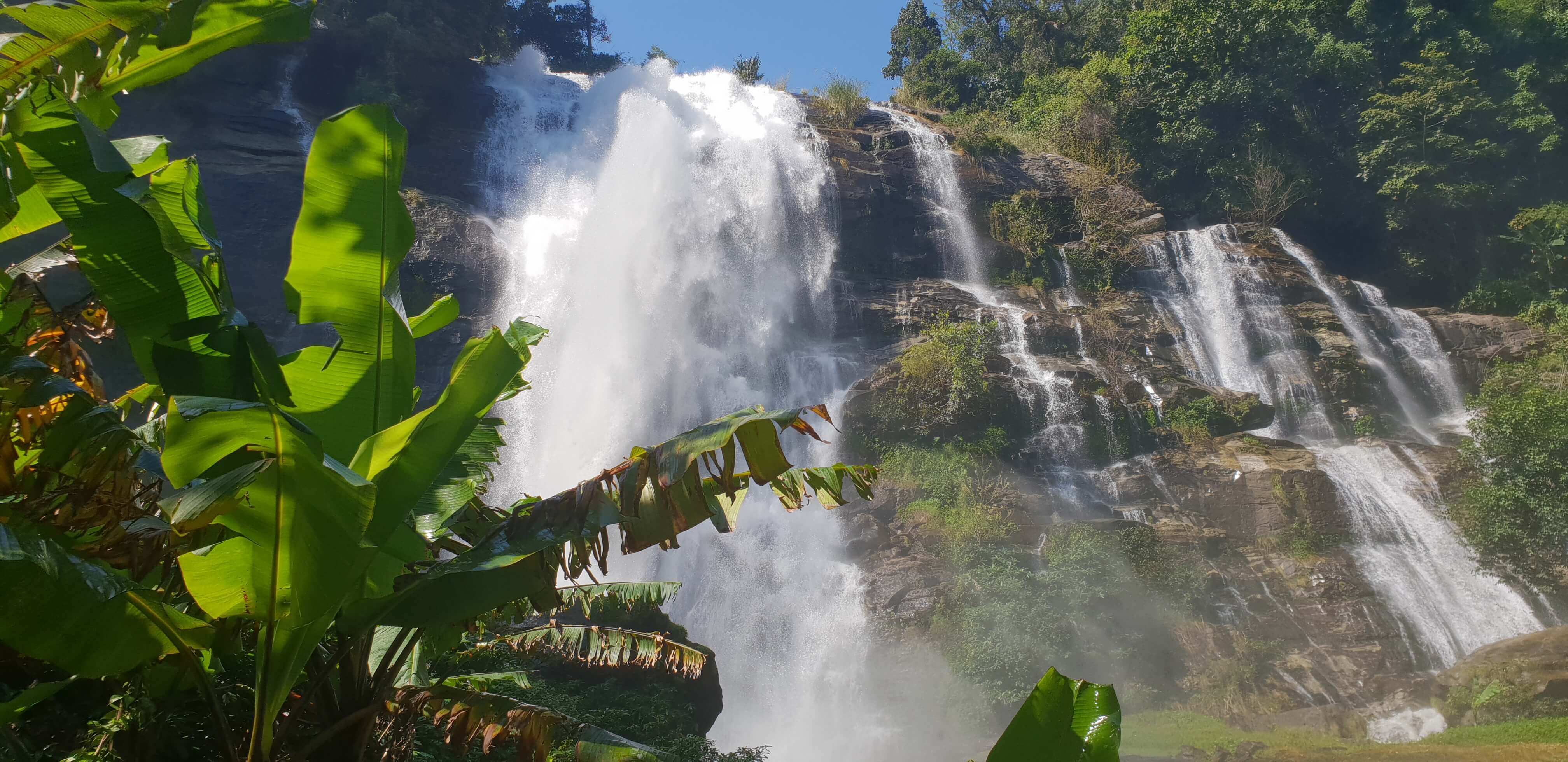
Wachirathan waterfall is one of the most popular waterfalls in Chiang Mai – a thing we figured out as soon as we reached the car park, right outside the waterfall park.
- The waterfall is a 45-minute drive from the Mae Ya waterfall and much closer to the Doi Inthanon National Park. It’s located next to Highway 1009 in the Ban Luang region of the Chom Thong district of Chiang Mai.
- I recommend you to buy the Doi Inthanon National Park ticket in advance so you don’t have to pay a separate entrance fee for this waterfall as it’s included in the National park ticket. Doi Inthanon National Park ticket costs 300 Baht for an adult, 150 baht for a child.
- There’s a small concrete path up to the waterfall. The strength of the water flow can be understood from the fact that halfway through the climb, you can feel sprays of water on your face.
- Wachirathan is translated as “Diamond Creek” and the waterfall certainly lives up to it’s reputation. You see a line of segmented waterfalls with the water cascading down the cliff. The waterfall stands at a cumulative height of 80m.
- My absolute favourite part of the waterfall was a colourful rainbow formed right at the base of the waterfall. It was surreal to see a noticeably big and clear rainbow that was unperturbed by the sprays of water resulting from the waterfall. It kissed the flora in it’s way and merged skillfully with the rocks. My guide told me that the rainbow resulted in the waterfall being called “Rainbow waterfall”.
- The water flow was aggressive and you had to scream to be heard when standing near the thundering waterfall. It was a spectacular sight with the rainbow at the base and was undoubtedly the most photogenic spot anybody could ask for!
- You can walk a short trail down if you wish to get close to the waterfall. Be careful as the steps are extremely slippery and only hiking shoes with a good grip are recommended for this activity. The end result of the trail is worth it as you see a desktop wallpaper-like frame of the jaw-droppingly stunning waterfall.
- The park has well maintained clean toilets. It also has a cafe that serves coffee, tea and coconut water.
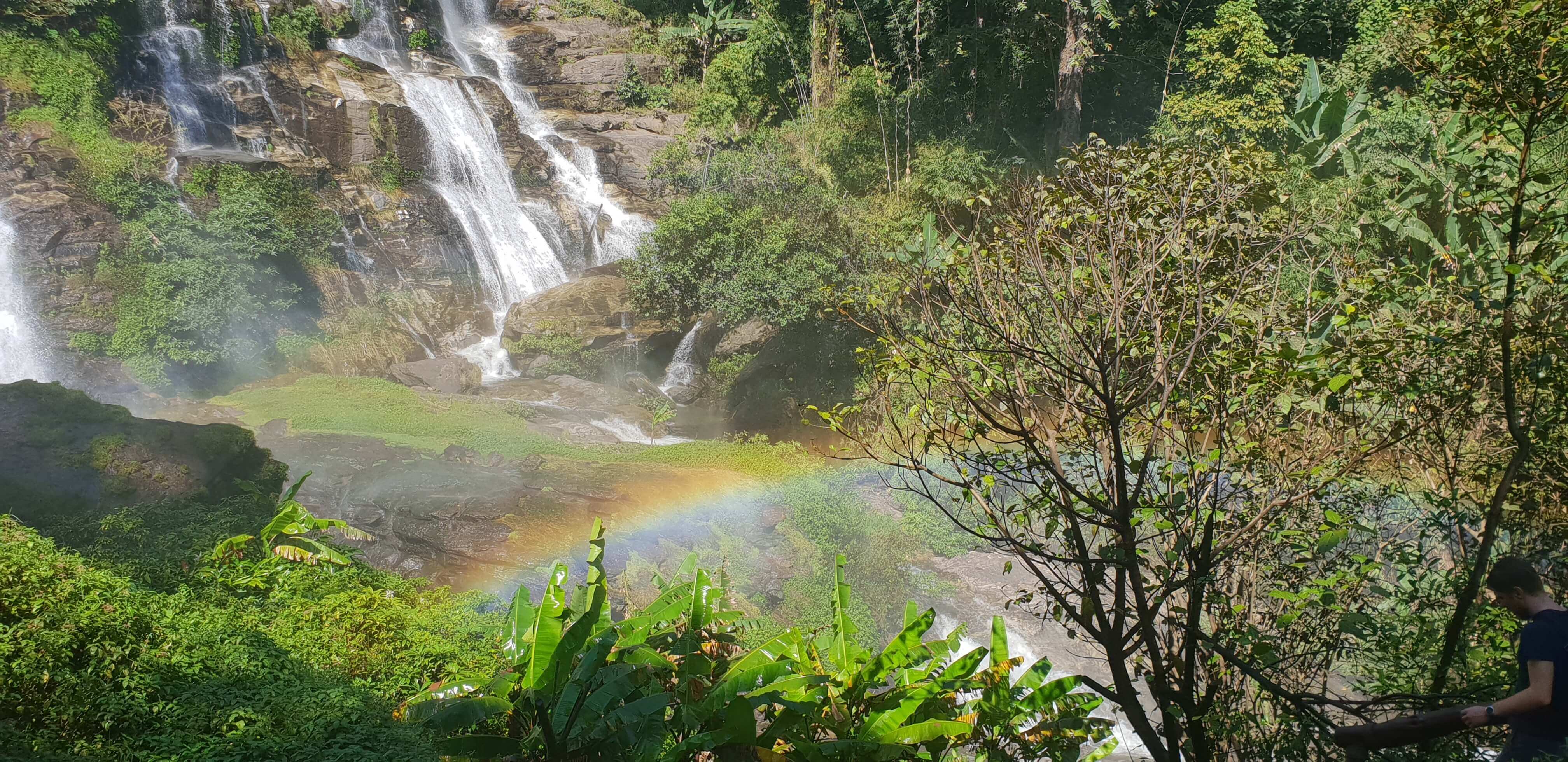
Wachirathan waterfall is undoubtedly the best waterfall in Chiang Mai. An added bonus is that you get to have a shower by default if you’re standing near the waterfall for a considerable period of time.
3) TREKKING THE PHA DOK SIEW NATURE TRAIL
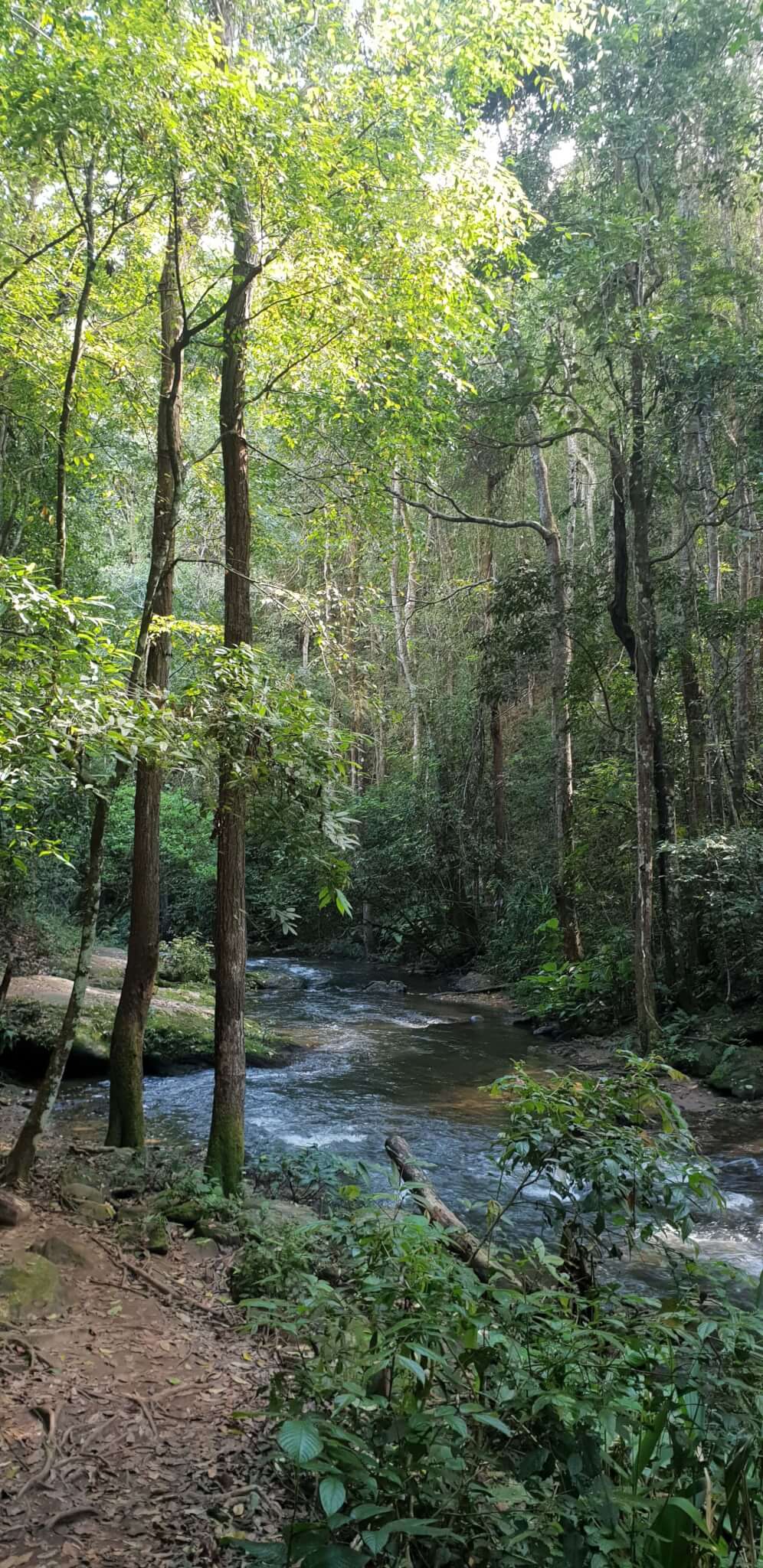
Doi Inthanon has a few nature trails to satiate the trekker in you. The two popular ones being – Pha Dok Siew and Kew Mae Pan.
- I chose the Pha Dok Siew nature trail as it has more scenic spots along the way. Also, it’s much easier to do with your family.
- Hiring a local guide is mandatory to walk the nature trail for safety purposes. Fees for the guide is 200 Baht.
- You’ll explore the forests of Doi Inthanon and come across flower plantations, a river, a series of waterfalls, a cute little bamboo bridge, paddy fields, strawberry farms on your way to the Mae Klang Luang village.
- It’s a two-hour trek which doesn’t feel tiring thanks to the picturesque waterfall stops in between.
- At the end of the trek, you get to visit the Mae Klang Luang village and taste their famous Arabica coffee with luscious strawberries (fresh from the farm).
- Good trekking shoes are recommended as the path does get steep and slippery at places.
4) TWIN PAGODAS
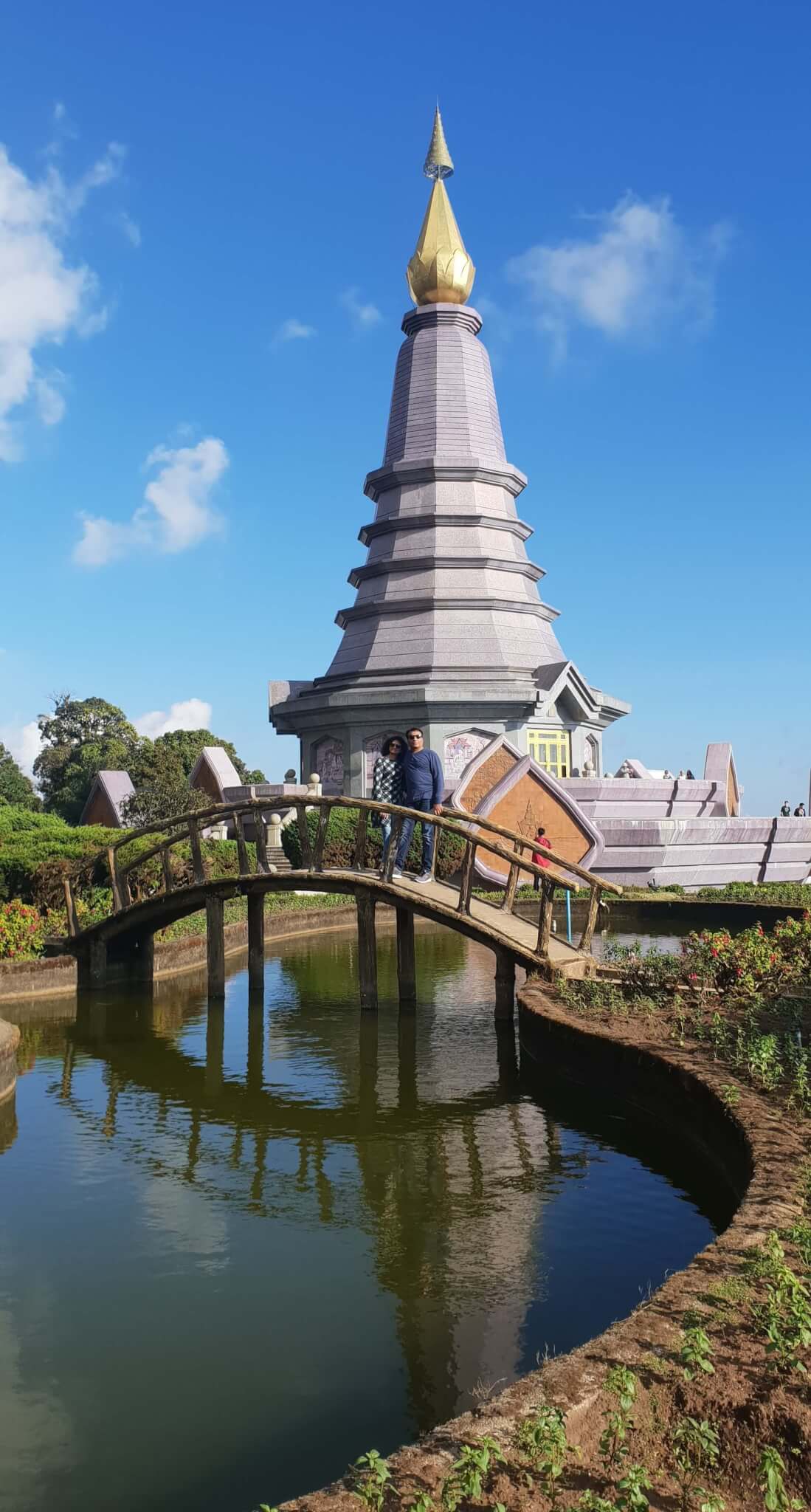
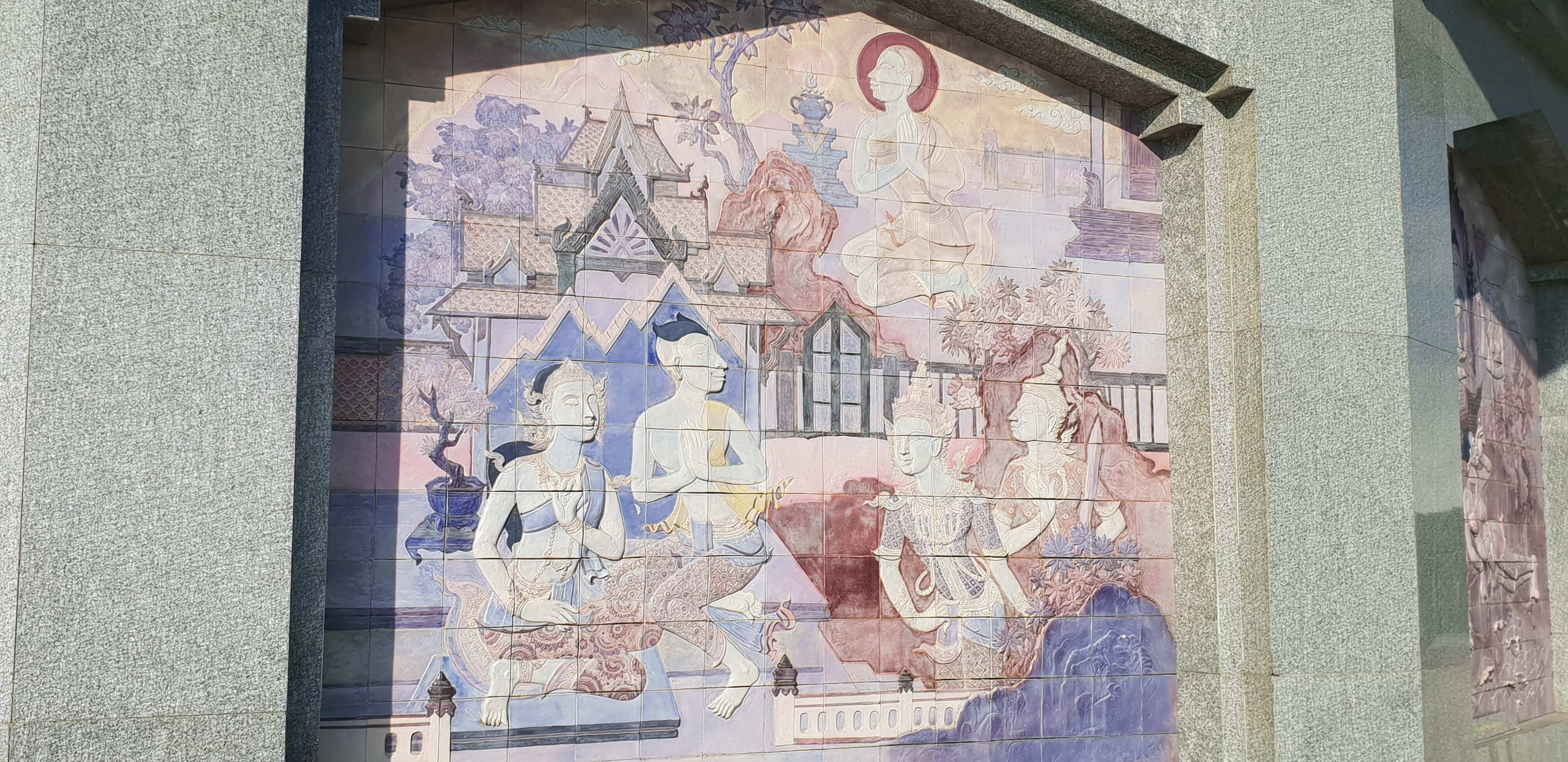
A day trip to Doi Inthanon is incomplete without visiting the Royal Twin Pagodas. You get to see these pagodas on your way to the summit of Doi Inthanon which is also the highest point in Thailand (2,565m).
- The Doi Inthanon National Park ticket costs 300 Baht but the Royal Twin Pagodas have a separate entry fee of 40 Baht per person.
- The Twin Pagodas were built by the Thai Army as a gift to the King and Queen in commemoration of their birthdays; the King Bhumibol Adulyadej’s 60th birthday in 1987 and the Queen Sirikit’s 60th birthday in 1992.
- You’ll see two adjacent similar looking beautiful pagodas – one in brown and the other in lavender. Apparently, the lavender coloured pagoda was built for the Queen and the brown coloured pagoda was built for the King.
- You can either use the escalators or climb up the stairs to reach the pagodas on each side.
- Inside the brown Pagoda built for the King, you’ll see a statue of Lord Buddha in a seated position with bas-relief structures on the walls. On the outside walls, you’ll see intricately built “brown stone base-relief paintings in square tile frames” depicting a story. I was impressed by the precision and the skill with which storytelling was being done through stone carvings. There’s an unkempt garden area around the pagoda.
- Inside the lavender Pagoda built for the Queen, is a standing statue of Lord Buddha with colourful frescoes covering the top half of the walls. Bas-relief sculpting forms the essence of the bottom half of the walls. On the outside walls are “colourful paintings in square tile frames” telling a story. Behind the Pagoda is a wonderfully maintained lush garden area with cherry blossom plantations. There’s also a small bridge over a pond filled with lots of fish. You can sit here, relax, click pictures and soak in the beauty on display.
- Looking at the two garden areas, I felt the King’s garden needed a salon session while the Queen’s garden was bigger, more beautiful and better groomed.
- However, the thing that wins you over is the one-of-a-kind magnificent panoramic view of Doi Inthanon from the Pagodas. When you’re up there at the Pagoda, a chilly breeze along with visuals of the endless green belt of the National Park soothe you into a state of calm.
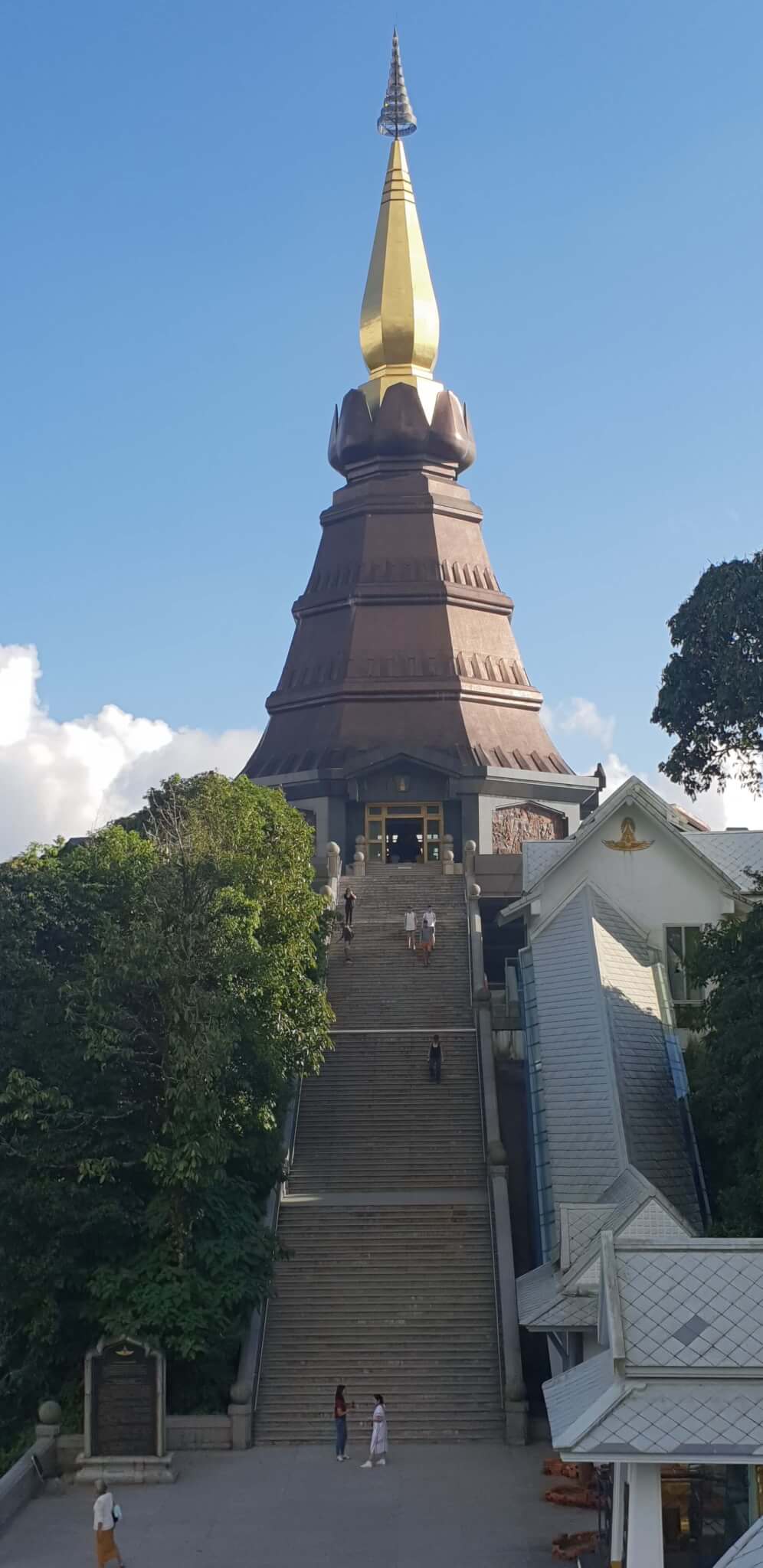
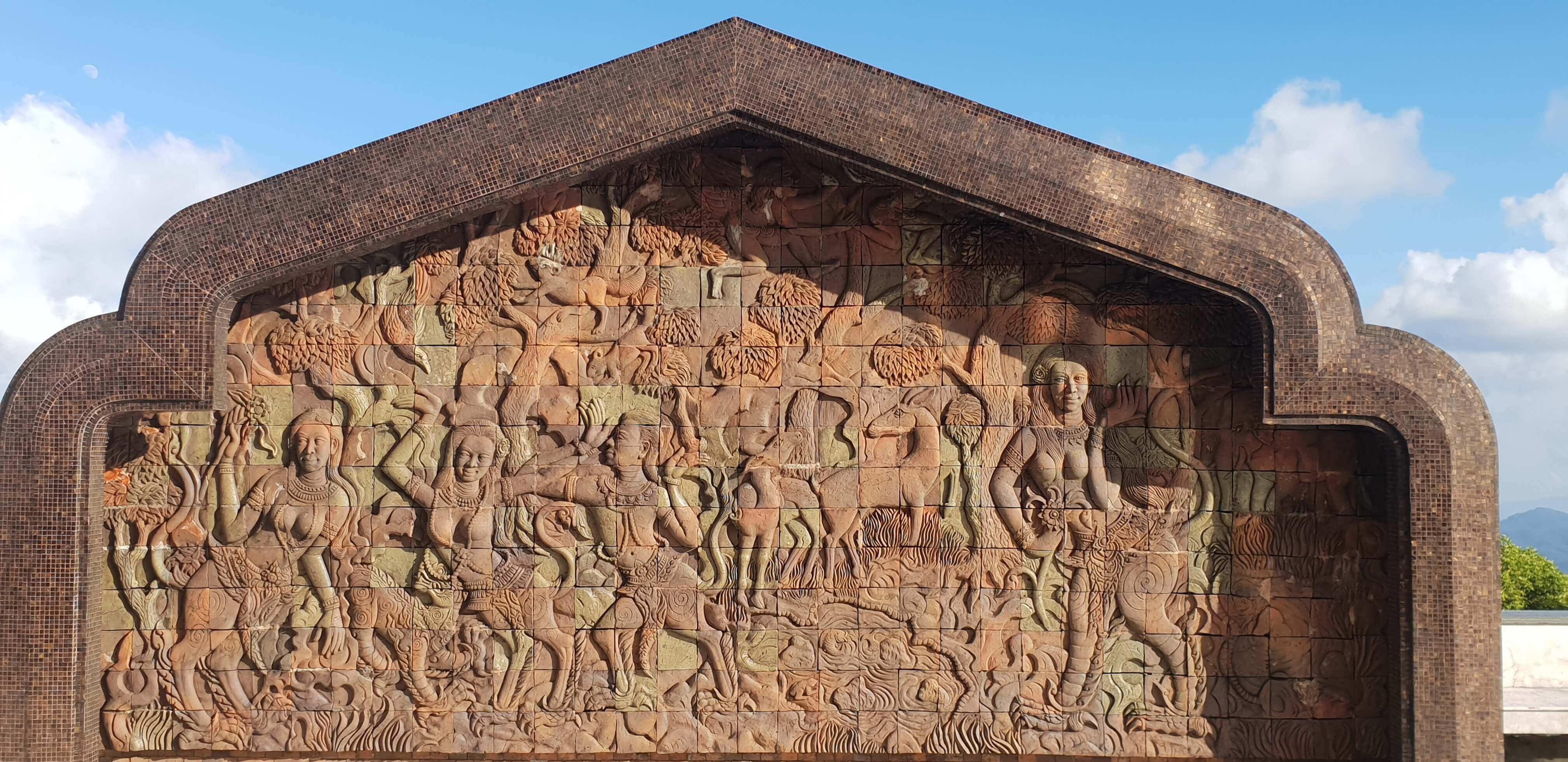
Visiting this place is surely an experience and a meditative one at that! The Twin Pagodas without a doubt is the best place to visit in Chiang Mai and a highlight of my day-trip to Doi Inthanon.
5) HMONG MARKET
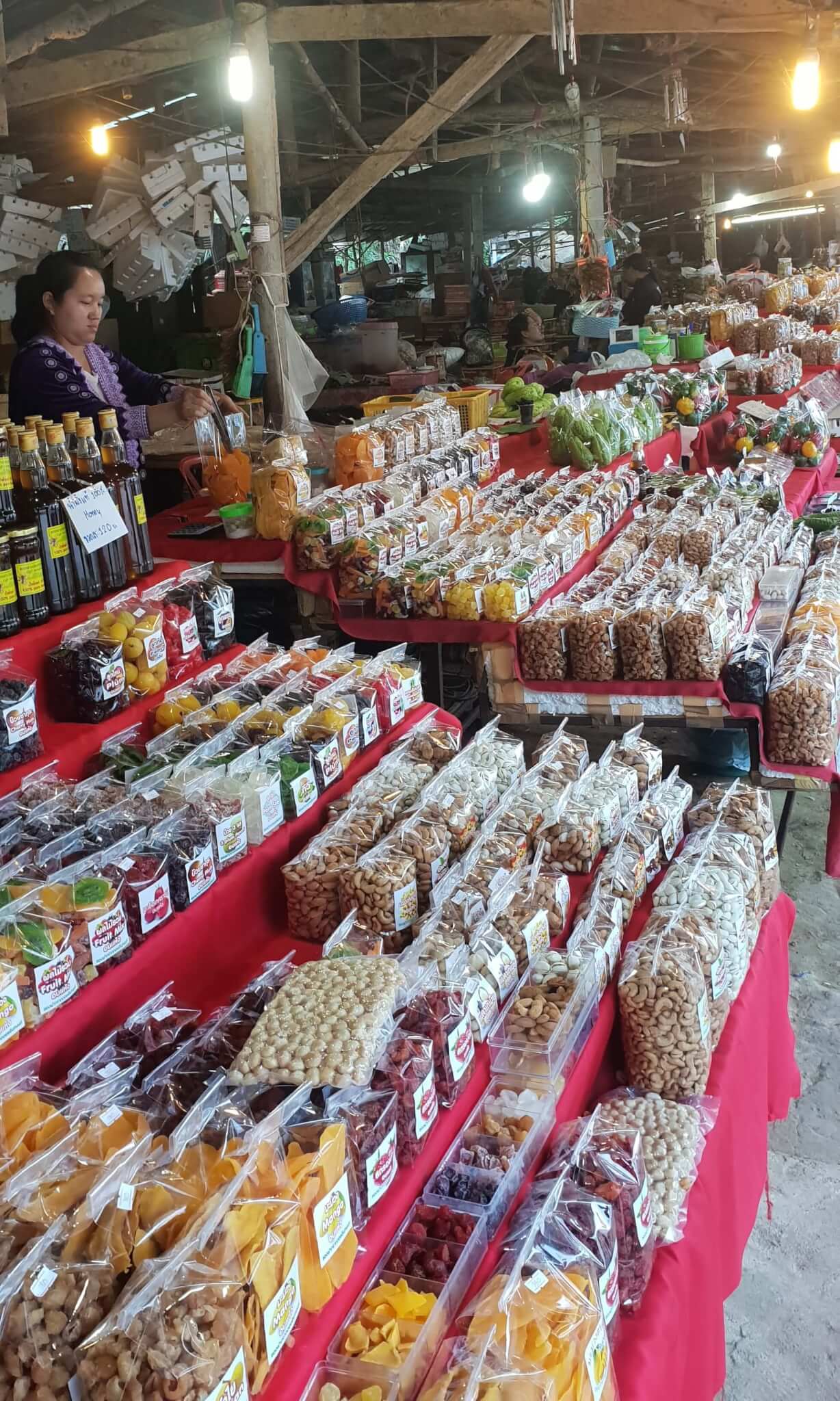
On your way back from Doi Inthanon to Chiang Mai, you’ll see a local market across the street, right opposite the area where camping tents are set up in Doi Inthanon. This place is called the Hmong market.
- The market is an organized line of tarpaulin-covered stalls in one place. Here the Hmong villagers sell local produce like vegetables, fruits, nuts, jams, authentic dry fruits, handbags, purses, Mongkud wine, distilled Koyote Lumka alcohol and even handmade stoles and other garments.
- There’s a nice buzz throughout the market with vendors smiling at you if they see you’re a tourist. Not the “we’re going to loot you” smile but more like “welcome to our village” smile.
- The garments – especially the local handmade stoles and skirts are of the highest quality and start from as cheap as 150 Baht. Fruits and veggies on sale are fresh too.
- The market wears a lively look in the evening with the lights coming on and is a good place for some cheap shopping.
- The only tip to shop here is to buy multiple items to get a bulk discount. Also, don’t forget to bargain from the stallholder.
WHERE TO STAY IN CHIANG MAI?
Accommodations in Chiang Mai are plenty. They can range from as low as $3 a day for a dorm to as high as $4000 a day in a 5-star resort. Here’s my listing of the best place to stay in Chiang Mai based on different budgets and different parts of the city you choose to stay in –
BEST BUDGET HOTELS IN CHIANG MAI
- Narittaya Resort and Spa – Check this place out and book your stay by clicking here
- Stay with Nimman – Check this place out and book your stay by clicking here
BEST ACCOR HOTELS IN CHIANG MAI
- Veranda High Resort – Check this place out and book your stay by clicking here
- Bodhi Serene – Check this place out and book your stay by clicking here
BEST ACCOMMODATIONS IN CHIANG MAI OLD CITY
- Tamarind Village – Check this place out and book your stay by clicking here
- Rachamankha a Member of Secret Retreats – Check this place out and book your stay by clicking here
BEST CHIANG MAI HOTELS (OVERALL)
- Shangri-La Hotel – Check this place out and book your stay by clicking here
- Le Meridien – Check this place out and book your stay by clicking here
- Anantara Chiang Mai Resort – Check this place out and book your stay by clicking here
BEST HOSTELS IN CHIANG MAI
- Best hostel for solo female travellers – Green Sleep Hostel – Book your stay by clicking here
- Best party hostel in Chiang Mai – Bodega Chiang Mai Party Hostel – Book your stay by clicking here
- Best flashpacker hostel in Chiang Mai – HOSTEL by BED – Book your stay by clicking here
- Best hostel in Chiang Mai (overall) – Stamps Backpacker Hostel – Book your stay by clicking here
BEST VALUE CHIANG MAI LUXURY ACCOMMODATION
CONTENT VILLA, CHIANG MAI
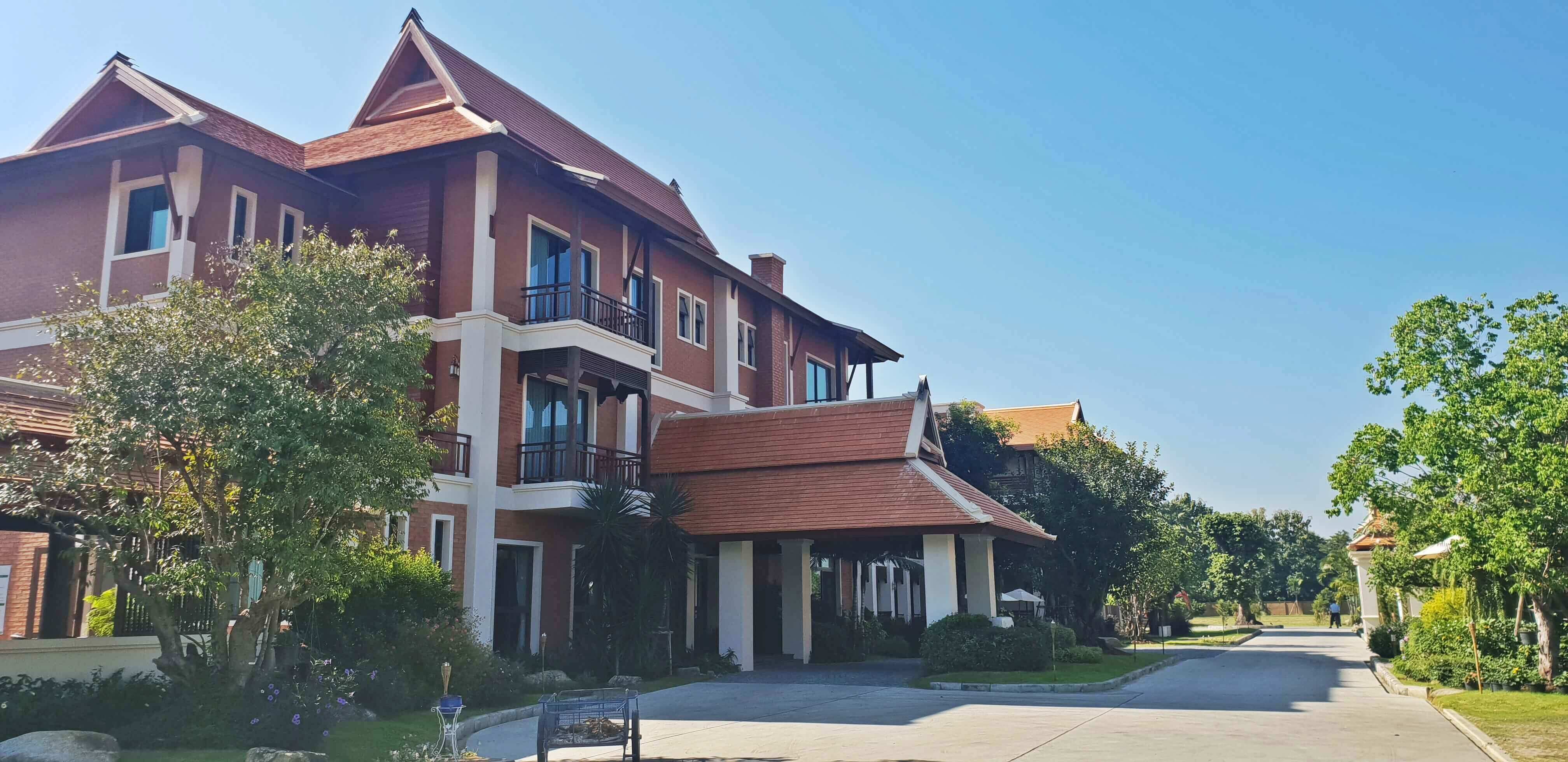
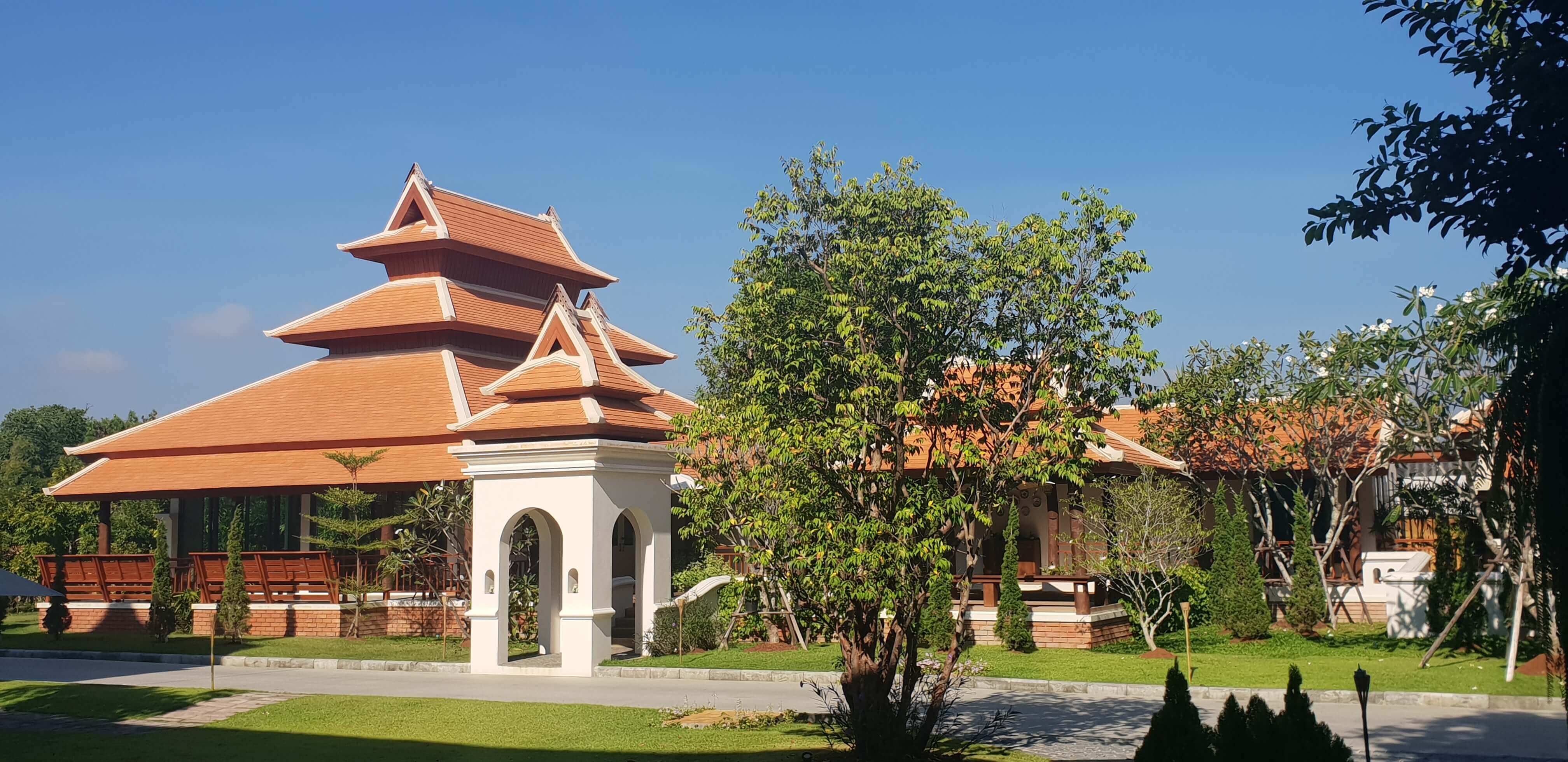
If I had to suggest you one of the cool places to stay in Chiang Mai, then Content Villa would be my top pick. Why Content Villa, Chiang Mai?
- It’s located in the best area to stay in Chiang Mai ie. Hang Dong. The area is peaceful, with no traffic or honking cars and outside the main city with lots of greenery all around. Beautiful mountain views are a common sight from this place.
- It gives you the 5-star hotel experience at a much much lower rate.
- It has a private swimming pool and some of the most luxuriously designed rooms with contemporary interiors (and a jacuzzi which doesn’t hurt)
- The breakfast menu is flexible and the made-to-order items were on point as well.
- They have the most comfortable bed and a buffet of the finest quality of pillows to ensure you sleep like a baby.
- They offer a free shuttle going to the glamorous places in the city like Night Bazaar, Night Safari and others so your transportation is sorted as well.
- They provide complimentary bicycles and a gym on their property so you can exercise and burn the calories you consume at their buffet breakfast.
- Their cafe is one of the best cafes in Chiang Mai. It has the most pristine and royal ambience that forces you to spend your time at the cafe not just for breakfast but even for an evening coffee.
- Their Spa offers massages at a really economical rate when compared to other hotels in the same league.
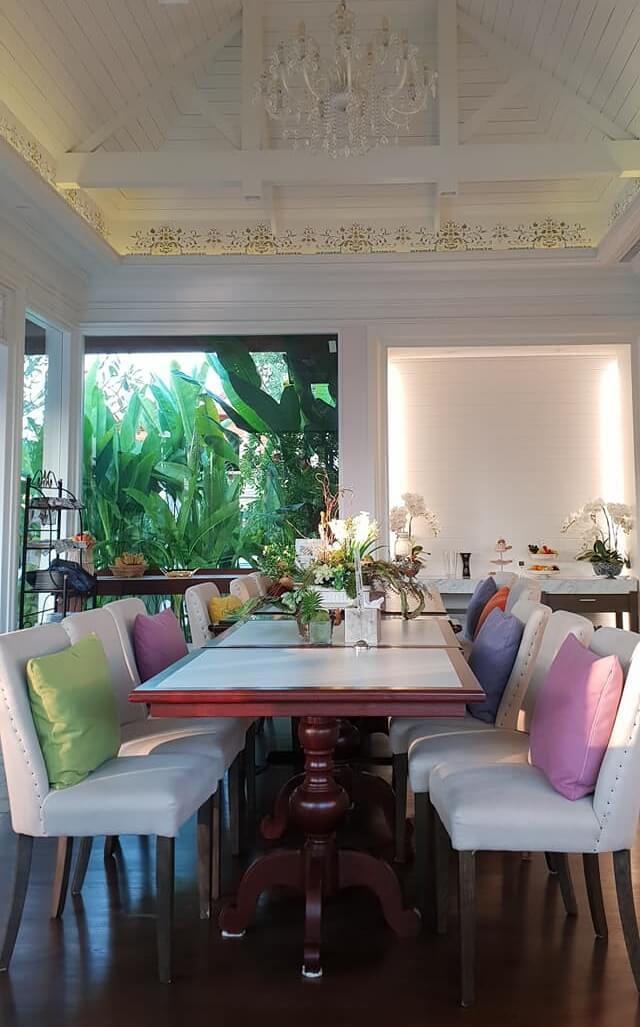

All the above reasons make Content Villa, Chiang Mai the best place to stay in Chiang Mai. So what are you thinking about? —> Book your stay at the Content Villa, Chiang Mai by clicking here.
BEST RESTAURANTS WITH VEGETARIAN FOOD IN CHIANG MAI
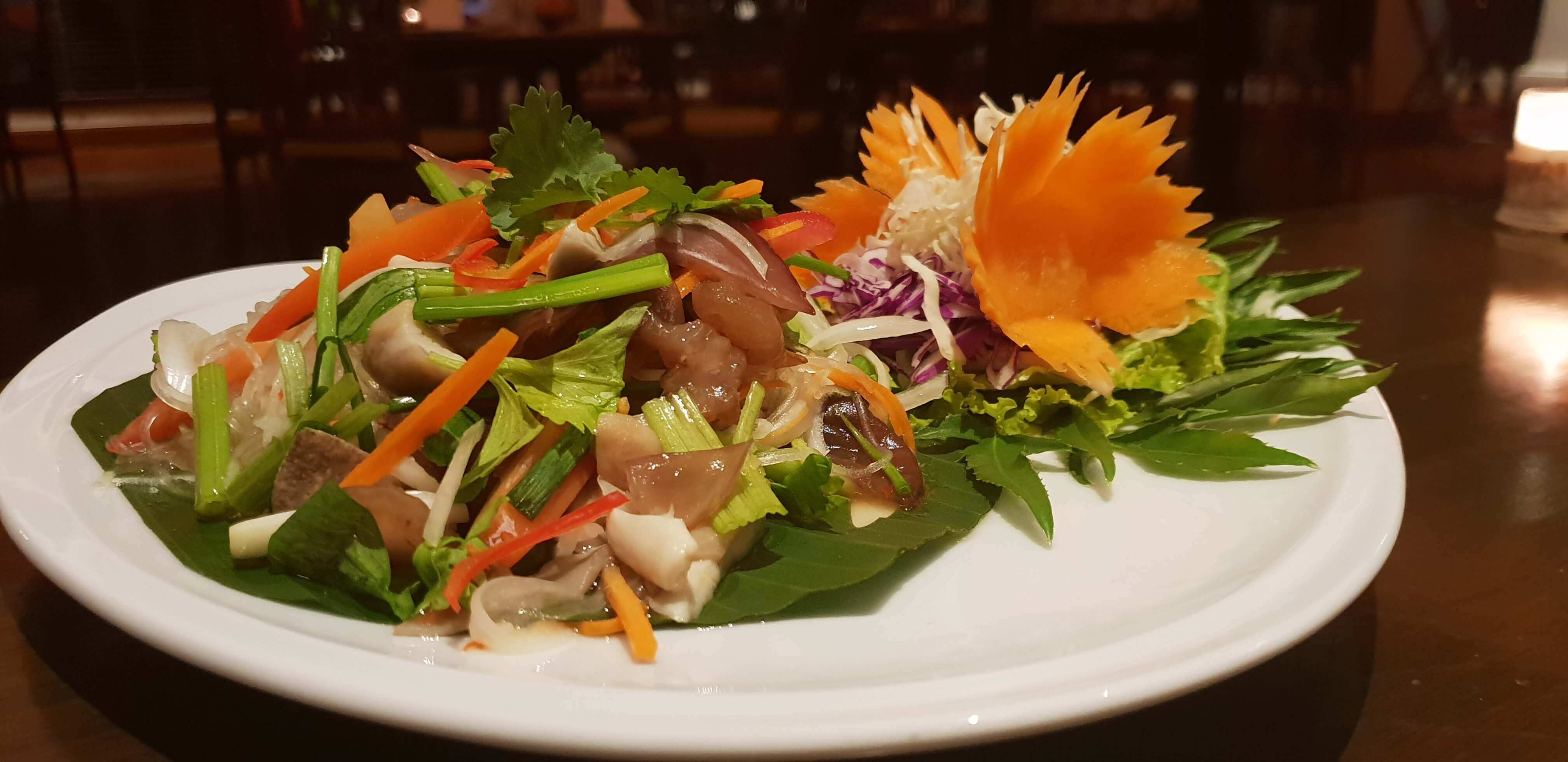
Vegetarian food in Thailand isn’t that difficult to find. And Chiang Mai is no different. There are many Thai vegetarian eateries throughout Chiang Mai that offer quality Thai vegetarian food. Some of my favourites among them are :
1. RAJDARBAR
- They offer the best Indian vegetarian food and have an indoor as well as a small outdoor seating. Try their vegetarian dishes like Paneer makhani, Chickpea curry, Spinach Paneer, Dal Tadka, Paneer Malai Tikka, Naan (bread), Samosas.
- Staff is really friendly, attentive and make you feel at home.
- Address: 99/2 Loi Kroh Rd, Tambon Chang Khlan, Amphoe Mueang Chiang Mai, Chang Wat Chiang Mai 50100, Thailand
2. AUM
- If you’re searching for some economical vegetarian Thai food, then this place is the right fit for you. Can be difficult to find as it doesn’t look like a typical restaurant but a home-like setting.
- Try their signature maki rolls, spring rolls, veg sushi, fried pumpkin with tempeh, veg khao soi among other Thai vegetarian dishes. The place also has cosy upstairs dining.
- Address: 1/4 Suriyawong Road Haiya, next to Black Canyon Coffee at Tha Phae Gate, Chiang Mai, Thailand.
3. ANCHAN
- Good quality vegetarian food that’s moderately priced. The menu is written on a chalkboard and keeps changing depending upon the vegetables available in the season.
- Try their fresh stir-fried veggies, tom yum soup, veg tempura with mushroom, cashew pad thai, banana flower salad & mint smoothie. Food portions are generous. Their vegan chocolate cake is a must eat!
- Address: Nimmanhaemin road, Hillside 2 Tambon Suthep, Amphoe Mueang Chiang Mai, Chang Wat Chiang Mai 50200, Thailand
4. PUN PUN
- The best part about this place is that they use fresh organic produce from their own farm to make food. They’re your one-stop shop for cheap good organic vegetarian food.
- Try their fried rice, pad thai, avocado salad with sprouts, tofu and fungus Larb, smoothies, juice & teas.
- Address: 6/1 Moo 1, Suthep Road, Wat Suan Dok, Chiang Mai 50200, Thailand (this place plays hide and seek in the grounds of a temple complex).
5. FREE BIRD CAFE
- This place is the best cafe in Chiang Mai in my opinion. Not only does it offer a diverse range of food items in terms of cuisine (Burmese, Western, Thai), but it also contributes to a humanitarian cause of providing education to refugee Burmese kids.
- The staff is friendly and speaks good English.
- Try their special Tea Leaf salad, spirulina bowl, mango pancakes and lavender latte.
- Address: 14 Sirimangkalajarn Soi 9, Chiang Mai, Thailand.
WHERE TO EXCHANGE YOUR MONEY IN CHIANG MAI?
When in a foreign country, the first thing you want to do is search for a money exchange centre that offers you good value for your currency.
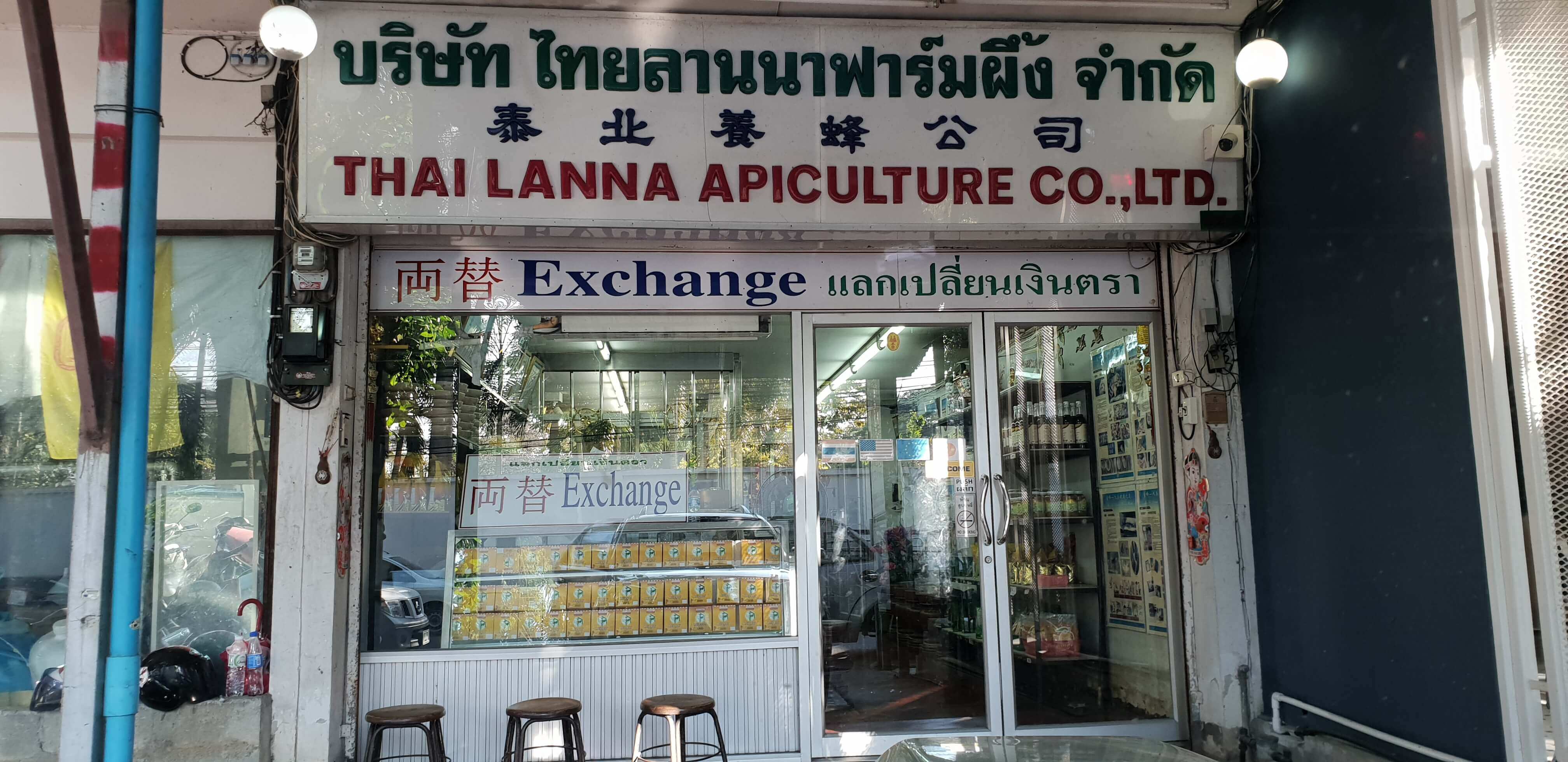
In Chiang Mai that place is the Thai Lanna Exchange Co. Ltd.
- It offers you the best rate on your currency with minimal additional charges as compared to the Chiang Mai airport and other centres that almost rip you off.
- Address: 92/9 Sridonchai Rd, Tambon Chang Khlan, Amphoe Mueang Chiang Mai, Chang Wat Chiang Mai 50100, Thailand.
- Open from 8am-8: 30 pm from Monday- Sunday.
- The centre also sells authentic high-quality bee products like bee hive, bee honey & bee pollen besides mango products so ultimately it’s a “sweet deal”.
FINAL THOUGHT
I hope my comprehensive guide of “What to do in Chiang Mai in 3 days” helps you plan and travel better. I have tried covering every topic that you might need help with, to explore the beautiful city of Chiang Mai.
SHARE the post for your future travel planning and if you have any doubts regarding anything, ask away in the comments. Also, I have written the current addresses for restaurants based on my visits so do remind me to update the address in the comments if there’s any change. Happy Travels!

1 comment
[…] of the most unique off-the-beaten-path hike experiences that I’d experienced was in Chiang Mai, Thailand , while hiking the Doi Inthanon National Park. Located in the Chom Thong district, the Doi Inthanon […]